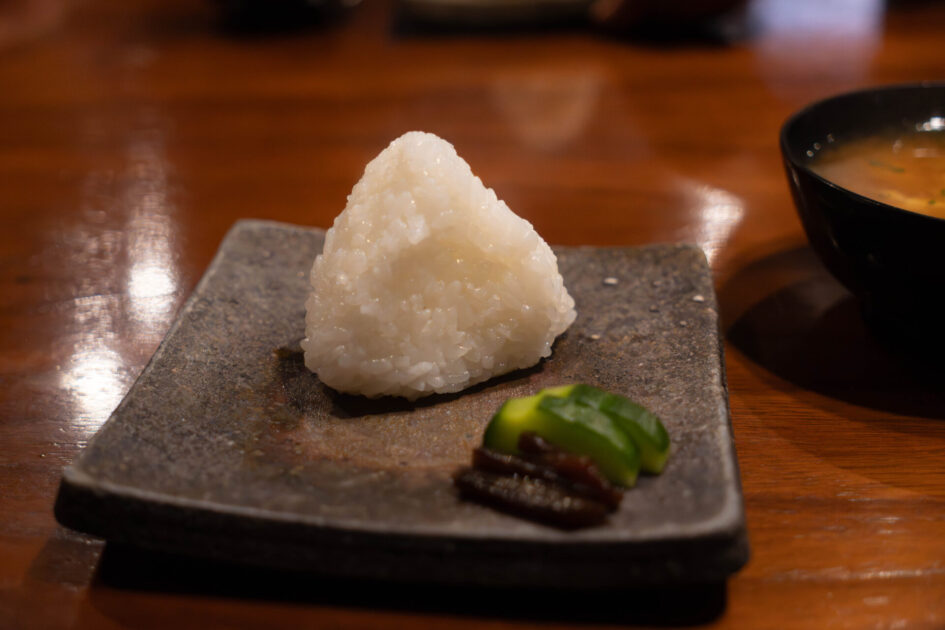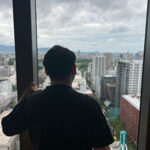CONTENTS
About Aru Tokoro
Concept
Located at the foot of Mt. Kagamiyama in Karatsu City, “Aru Tokoro” is a restaurant housed in a 130-year-old traditional Japanese home that has been lovingly renovated.
Its name, which comes from the opening line of old Japanese folktales — “Mukashi mukashi, aru tokoro ni…” (“Once upon a time, in a certain place…”) — carries a tone that invites guests into a storylike world.
Rather than relying on extravagant presentations or flashy techniques, the restaurant values cooking that is as simple and sincere as possible, drawing from the rich bounty of Karatsu’s sea and mountains.
Because the impression of fish, vegetables, and even rice changes with the slightest adjustment in heat or salt, Chef Hirakawa’s philosophy is to avoid unnecessary intervention — to “serve the ingredients just as they are.”
The space itself, which preserves the character of the old house, also exudes the charm of a scene from a story.
Earthen walls, a traditional kamado stove, and bamboo crafts create a warm, handcrafted atmosphere, offering a nostalgic yet serene environment in which to engage with the cuisine.
It feels as if the place itself embodies the restaurant’s concept.
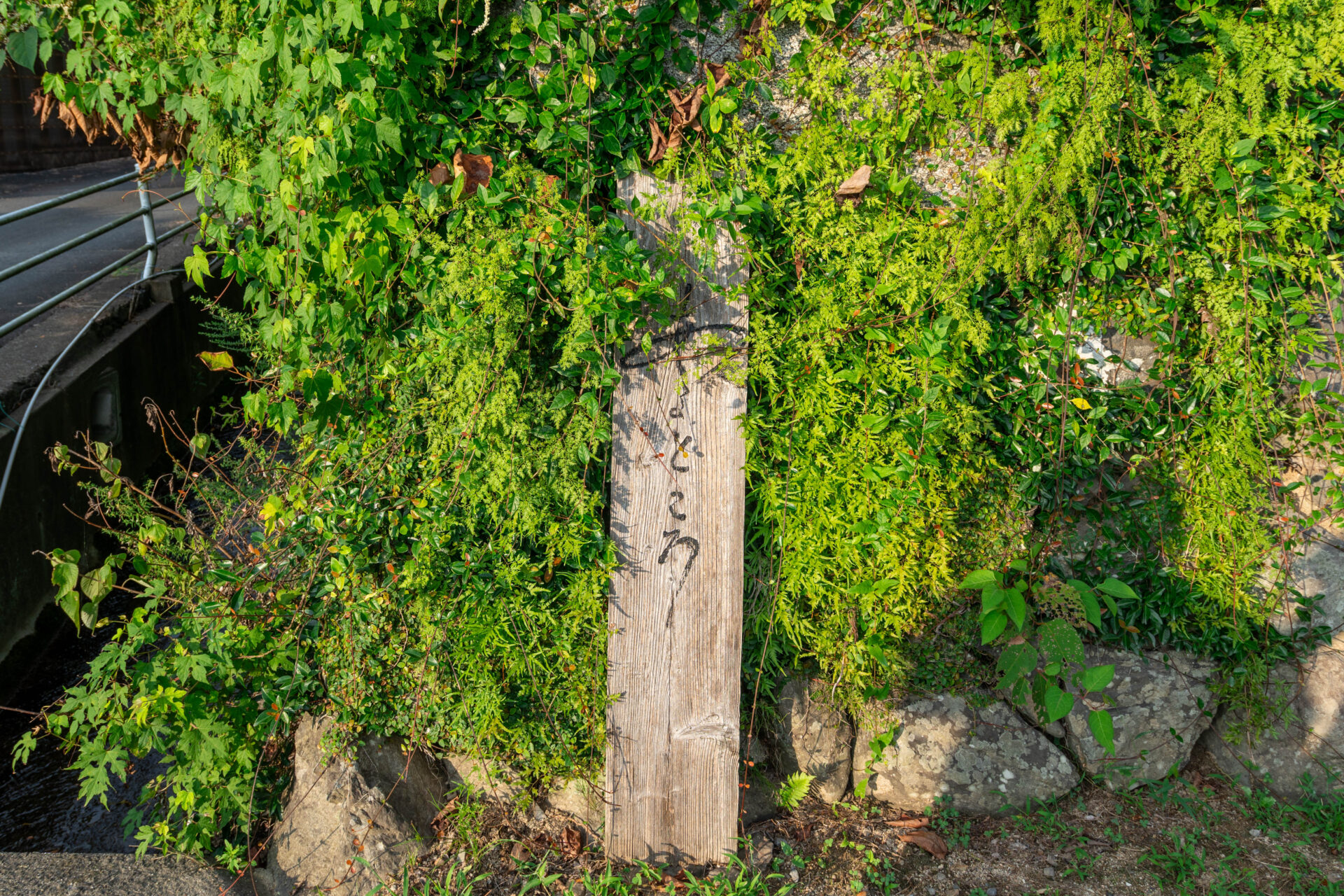
About the Chef: Nao Hirakawa
Chef-owner Nao Hirakawa was born in Fukuoka City in 1982.
After majoring in traditional crafts at university and immersing himself in creative work, he decided to pursue the path of cooking.
He trained at a kaiseki restaurant in Ginza, Tokyo, and at “Mikitou” in Midorigaoka, later honing his skills for about four years at the renowned “Tarafuku Manma” in Fukuoka.
The kamado-cooked rice balls (omusubi) he learned to make at “Tarafuku Manma” have become one of the signature dishes of Aru Tokoro.
Simple yet profoundly flavorful, they carry the spirit of his training.
In 2015, he renovated the 130-year-old home himself and opened “Aru Tokoro.”
The name expresses his wish that, just as in the phrase “Once upon a time, in a certain place…,” each visitor might discover their own “certain place” within themselves.
Hirakawa’s cuisine follows the principle of “subtraction rather than addition.”
He approaches ingredients with honesty, avoiding unnecessary decoration.
Through that attitude and the refined technique he has cultivated over the years, the ingredients of Karatsu shine all the more brightly, leaving a deep impression on every guest.
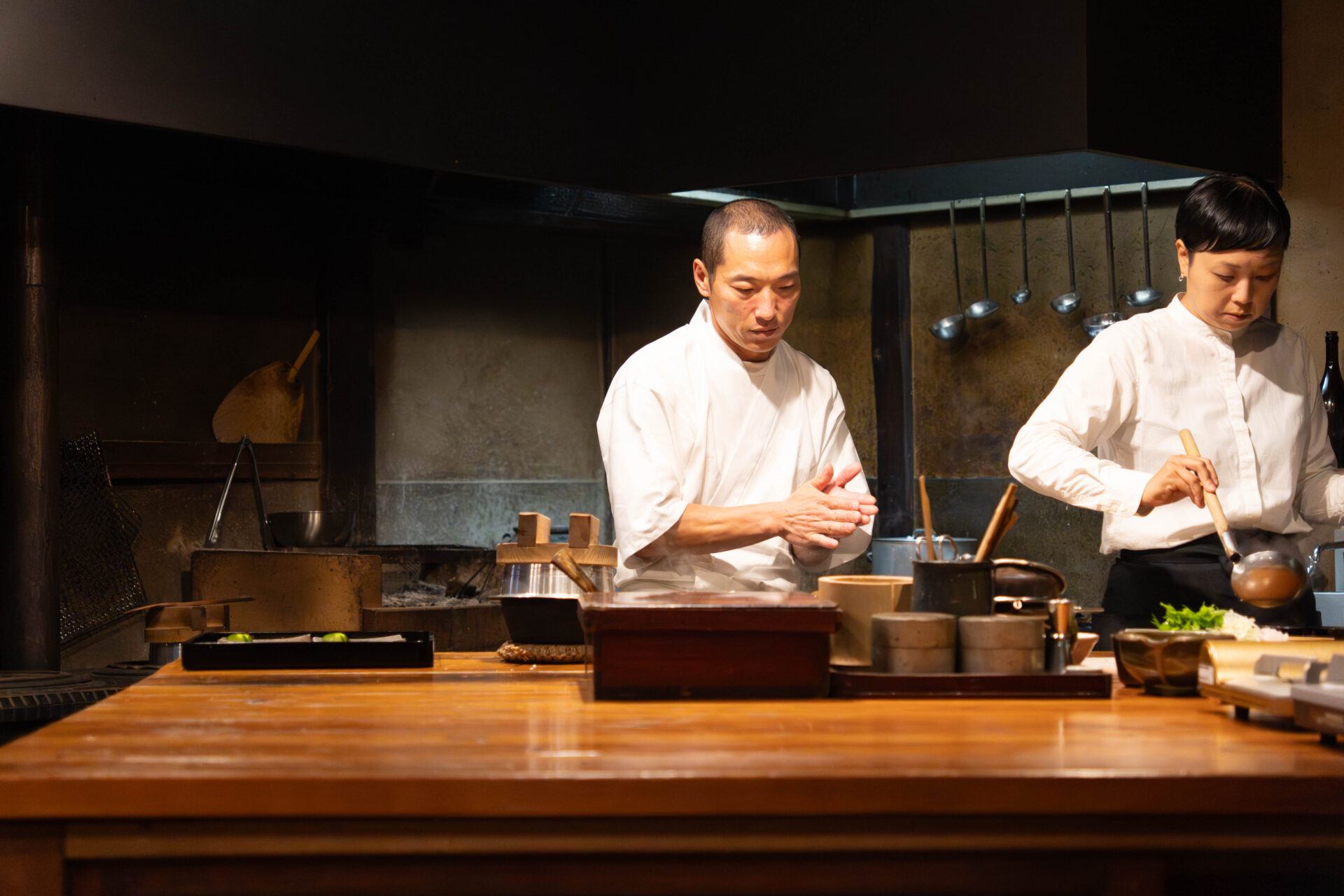
Restaurant Recognition
In the Michelin Guide Fukuoka, Saga & Nagasaki (2019 Special Edition), Aru Tokoro was awarded one Michelin star.
Despite its secluded location in the countryside, gourmets from across Japan make the journey to dine here — and it’s easy to see why.

Dining Prelude
Exterior & Entrance
Nestled quietly at the foot of Mt. Kagamiyama in Karatsu, “Aru Tokoro” appears at the end of a narrow path along a stone wall, in a renovated kominka (traditional Japanese home) over 140 years old.
A simple wooden sign bearing only the words “Aru Tokoro” stands by the overgrown path, inviting visitors into the opening scene of an old folktale.
Beyond the path, guests are welcomed by the main building with its lattice windows and a white noren curtain at the entrance.
Sunlight filters into the garden, where the old fittings and tiled roof quietly hold the passage of time.
Stepping inside feels like leaving behind the bustle of daily life and crossing into a storybook world.
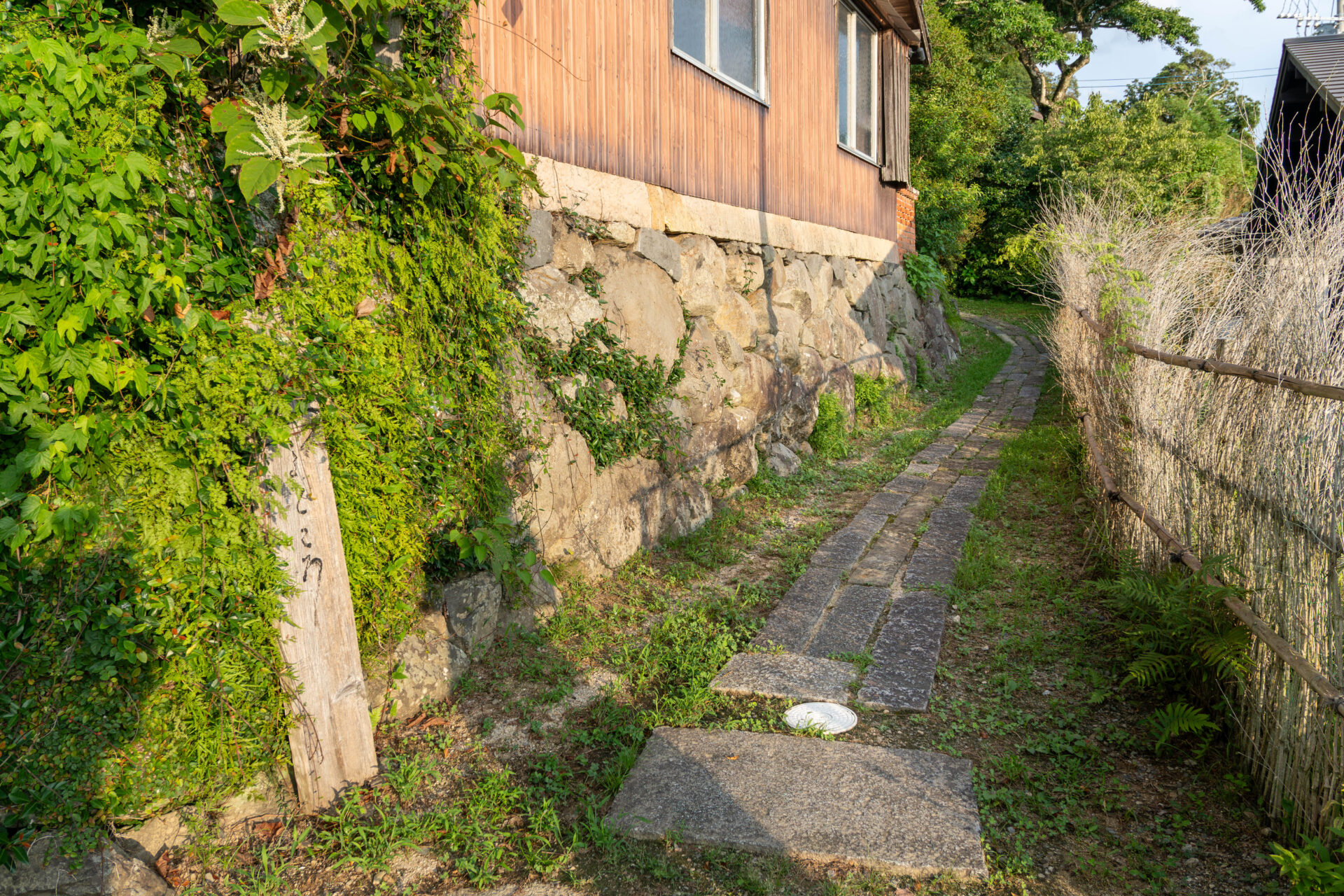
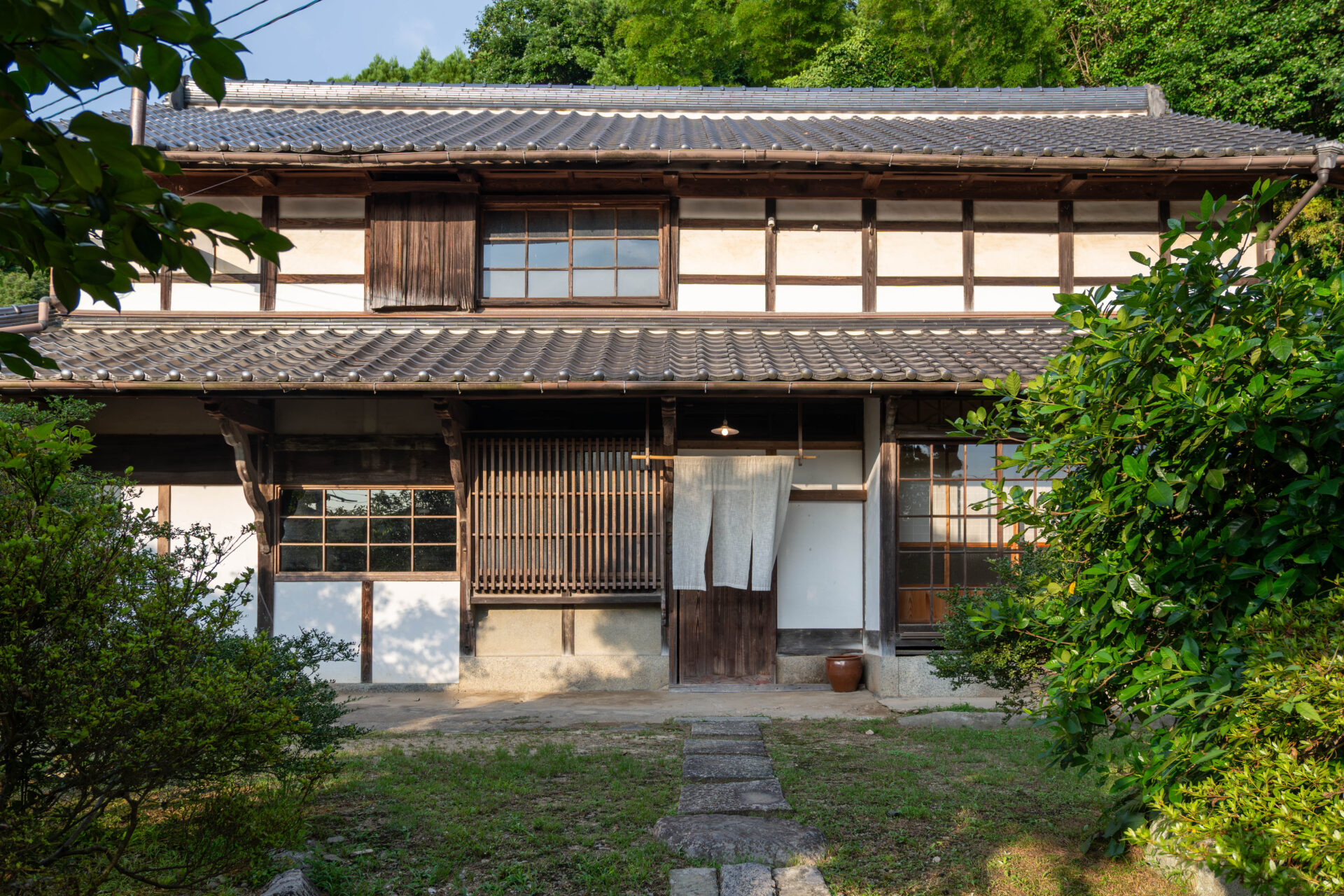
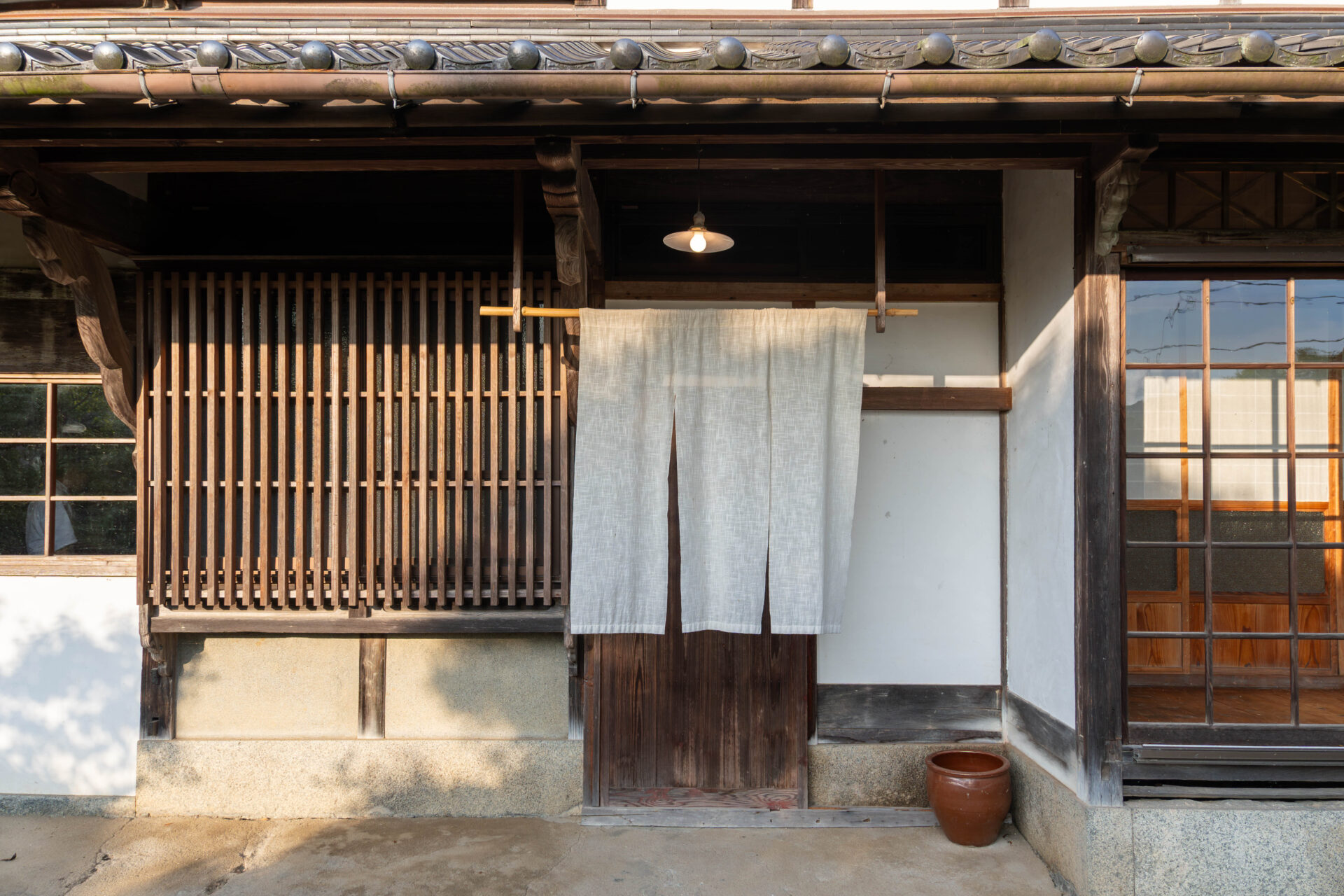
Dining Space
The dining room at “Aru Tokoro” was designed and renovated by Chef Nao Hirakawa himself.
Originally a tatami room, the floor was removed and converted into a dirt-floored doma space. The beams and earthen walls of the old home remain intact, paired with polished wooden tables and chairs, while a central counter serves as the chef’s stage.
An old onigawara (roof tile) of Ebisu, once placed atop the roof, now rests inside the restaurant, quietly watching over the space and its history.
Soft clarinet duets play in the background, filling the room with a gentle rhythm — as if the music itself were narrating a scene from a folktale, guiding diners through the story of their meal.
Rather than feeling like a formal restaurant, it’s more like being welcomed into someone’s kitchen hearth.
Even the chef’s gestures and the flicker of the fire become part of the experience — transforming the space into something truly one-of-a-kind.
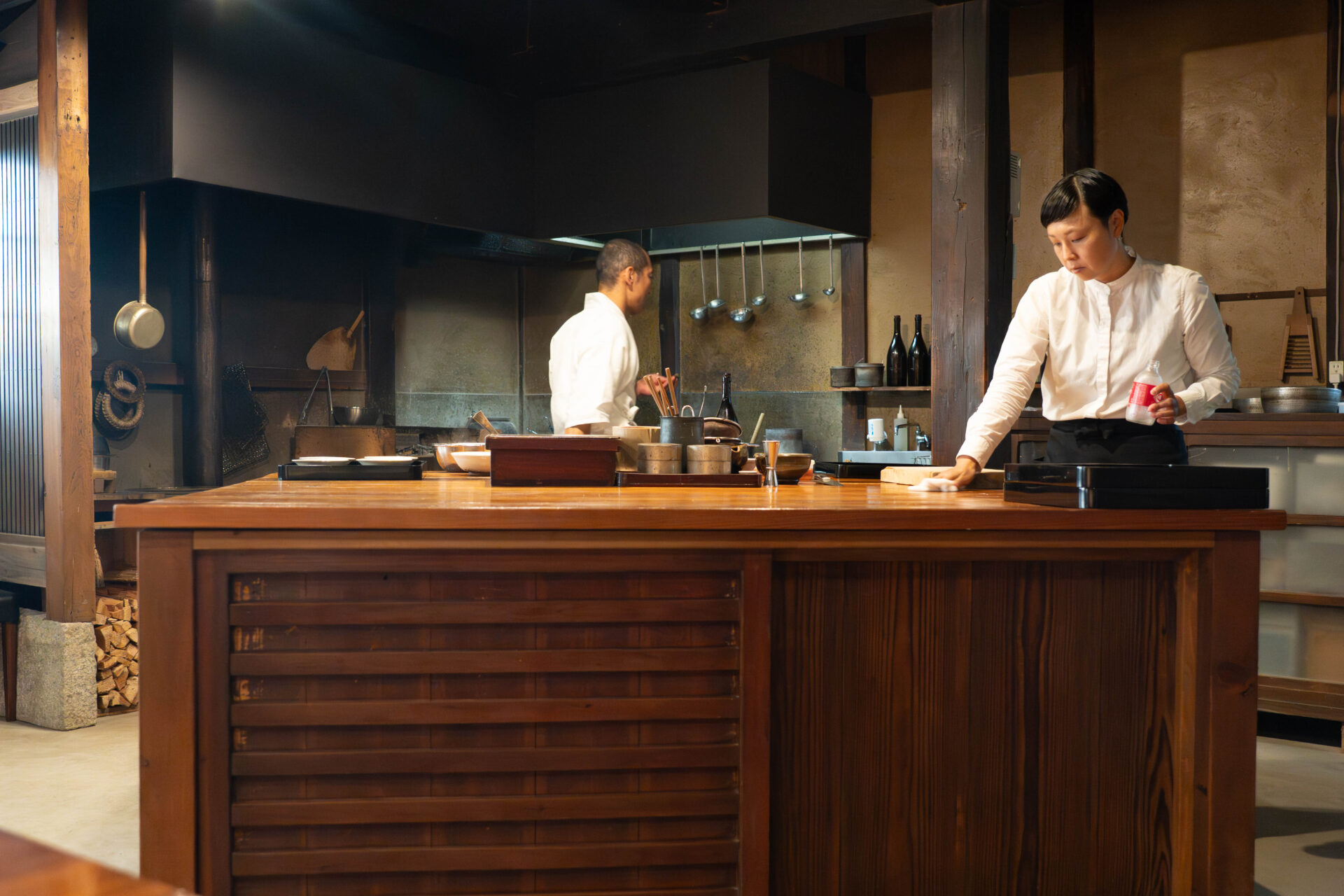
Menu Presentation
At “Aru Tokoro,” guests are served an omakase course entrusted entirely to Chef Hirakawa.
The menu centers around the finest local ingredients from the sea and mountains of Karatsu, changing daily with the seasons and availability.
Some courses return to the fundamentals of Japanese cuisine — like the simplicity of ichiju-sansai (one soup, three dishes) — while others, such as the kamado-cooked rice balls served at the end, remain deeply memorable.
Especially the closing “onigiri,” a direct inheritance from his training at “Tarafuku Manma,” stands as a symbolic dish of this place.
With perfectly balanced sweetness, texture, and salt, it’s the kind of dish that makes you crave another bite.
Rather than a showy feast, it is a soulful omakase — a time to taste the blessings of Karatsu, naturally and sincerely through the chef’s hands.
Like the continuation of a folktale that begins with “Once upon a time, in a certain place…,” each guest leaves with their own unique memory of the story.
Dishes Tasted
Blanched Malabar Spinach (Tsuru-murasaki Ohitashi)
The meal began with seasonal greens — blanched Malabar spinach dressed simply in dashi.
Its vibrant green stood out beautifully in the dish, with the aroma of shaved bonito gently wafting up.
With one bite, its smooth, slightly viscous texture spreads across the palate, blending with the umami of bonito broth for a soothing finish.
Unassuming yet deeply flavorful, it was a dish that warmed both body and heart.
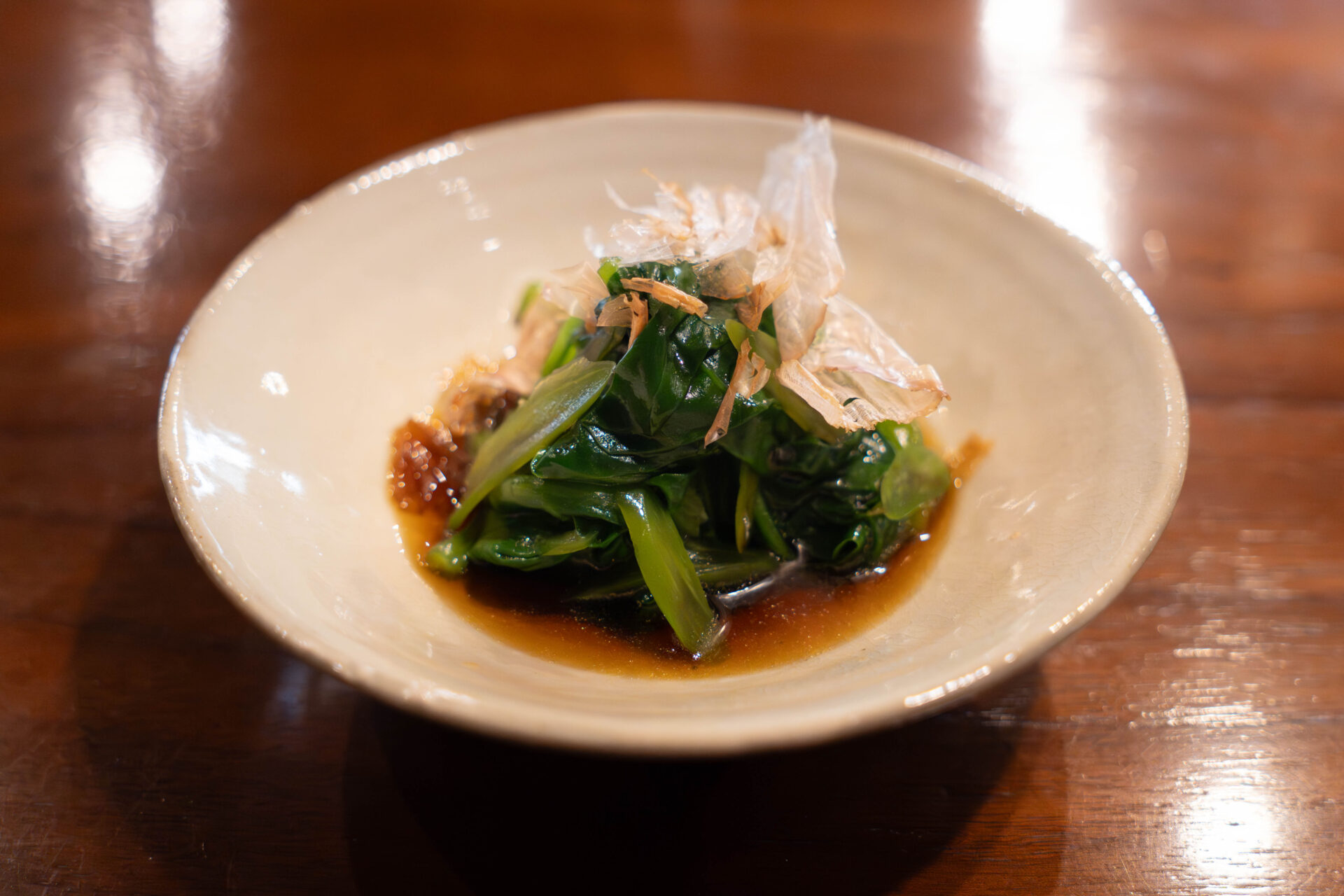
Marinated Tomato in Vinegar
Next came a refreshing small bowl of marinated mini tomatoes.
Peeled and lightly dressed with dashi-infused vinegar, topped with finely chopped onions for a crisp accent.
The sweetness and acidity of the tomato were perfectly balanced, with the subtle aroma of the onion sharpening the finish.
A dish that captured the brightness of early summer in both color and taste.
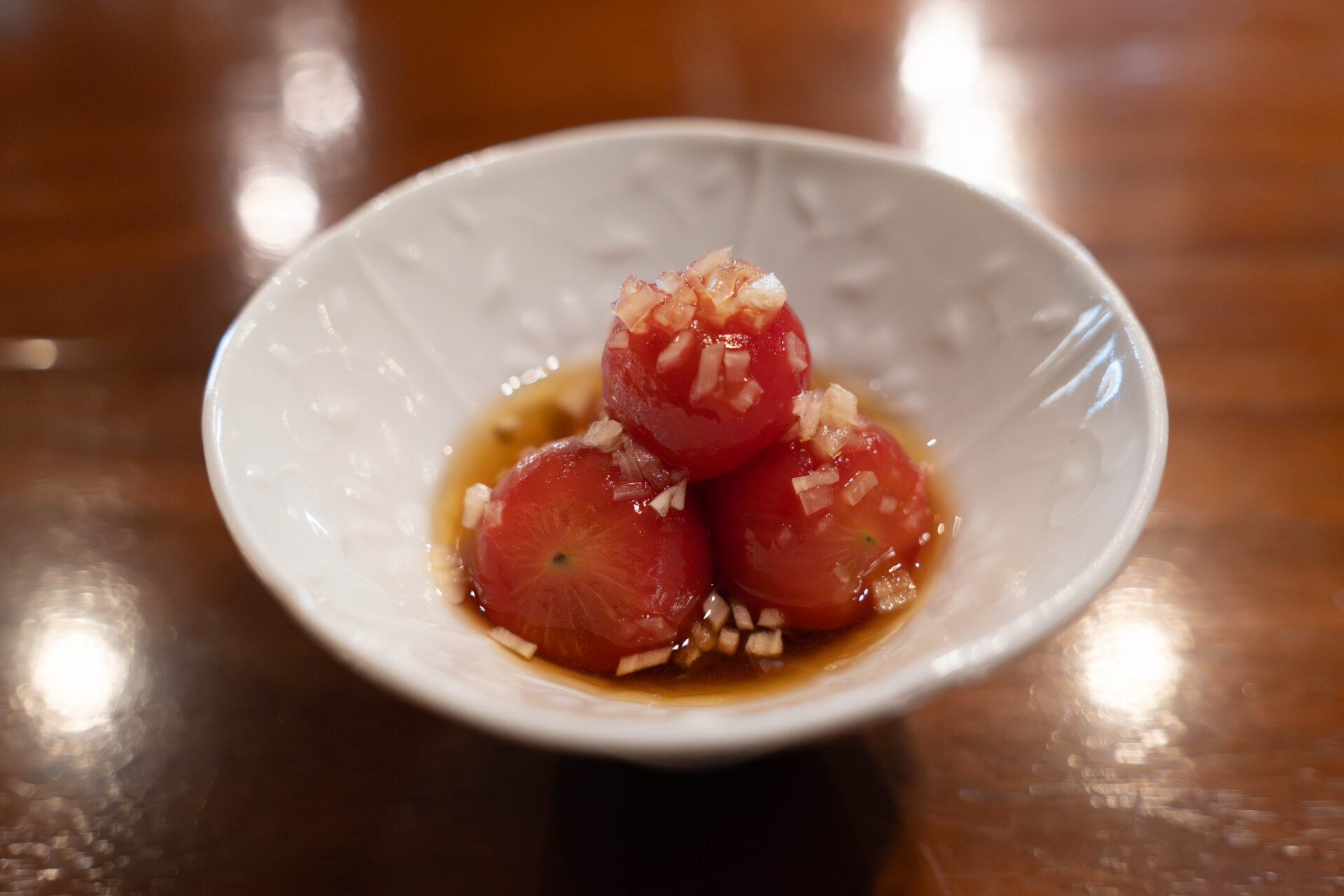
Yari-ika Sashimi “Ika Somen” – Squid Noodles from Karatsu
Fresh spear squid (yari-ika) from the waters of Karatsu, finely sliced into noodle-like strands.
Translucent and glistening white, it is astonishingly smooth on the tongue, releasing a natural sweetness as you chew.
Served chilled in light dashi and paired with fresh ginger, which enhances the squid’s delicate flavor.
A minimalist dish that fully showcases the strength and purity of its ingredient.
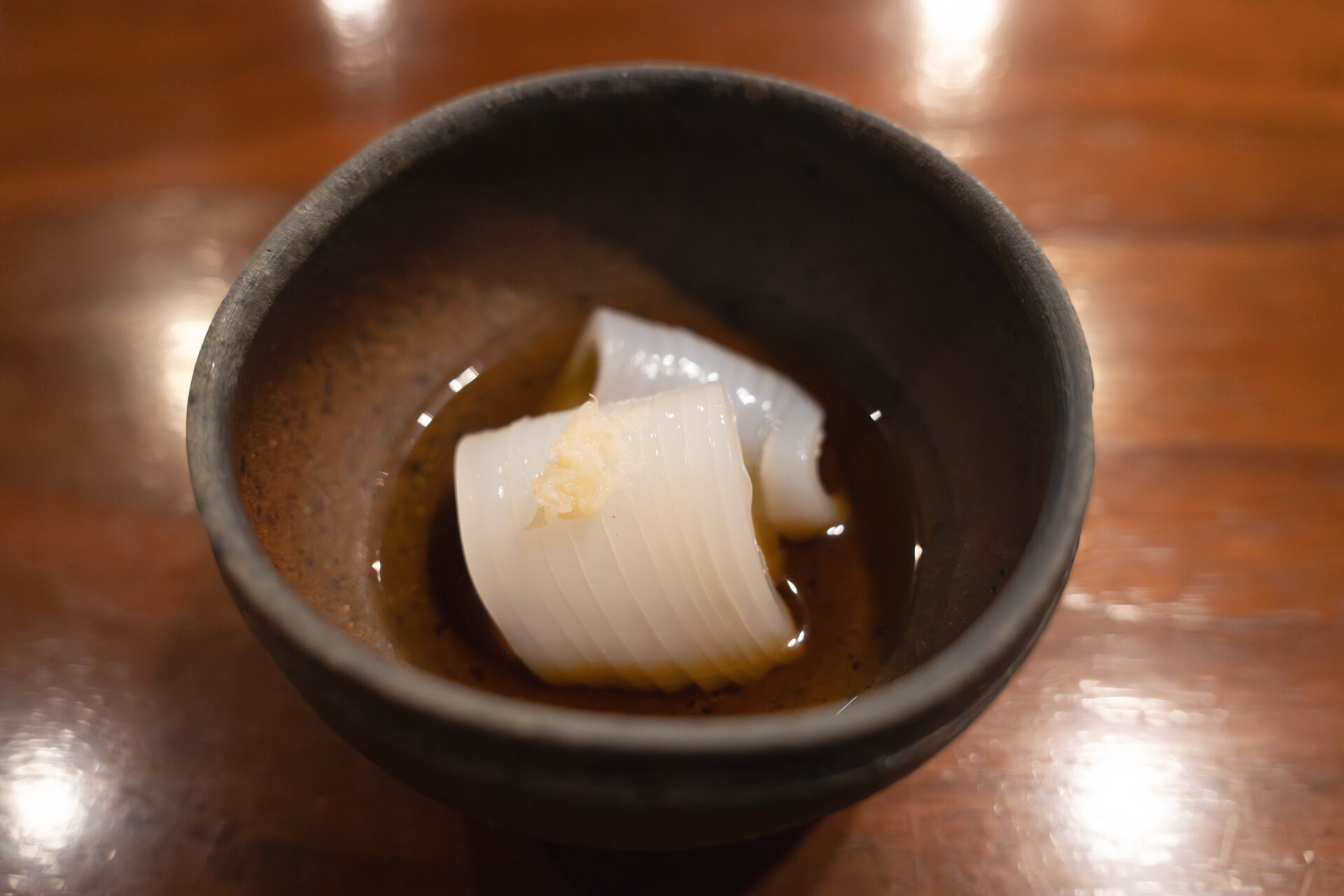
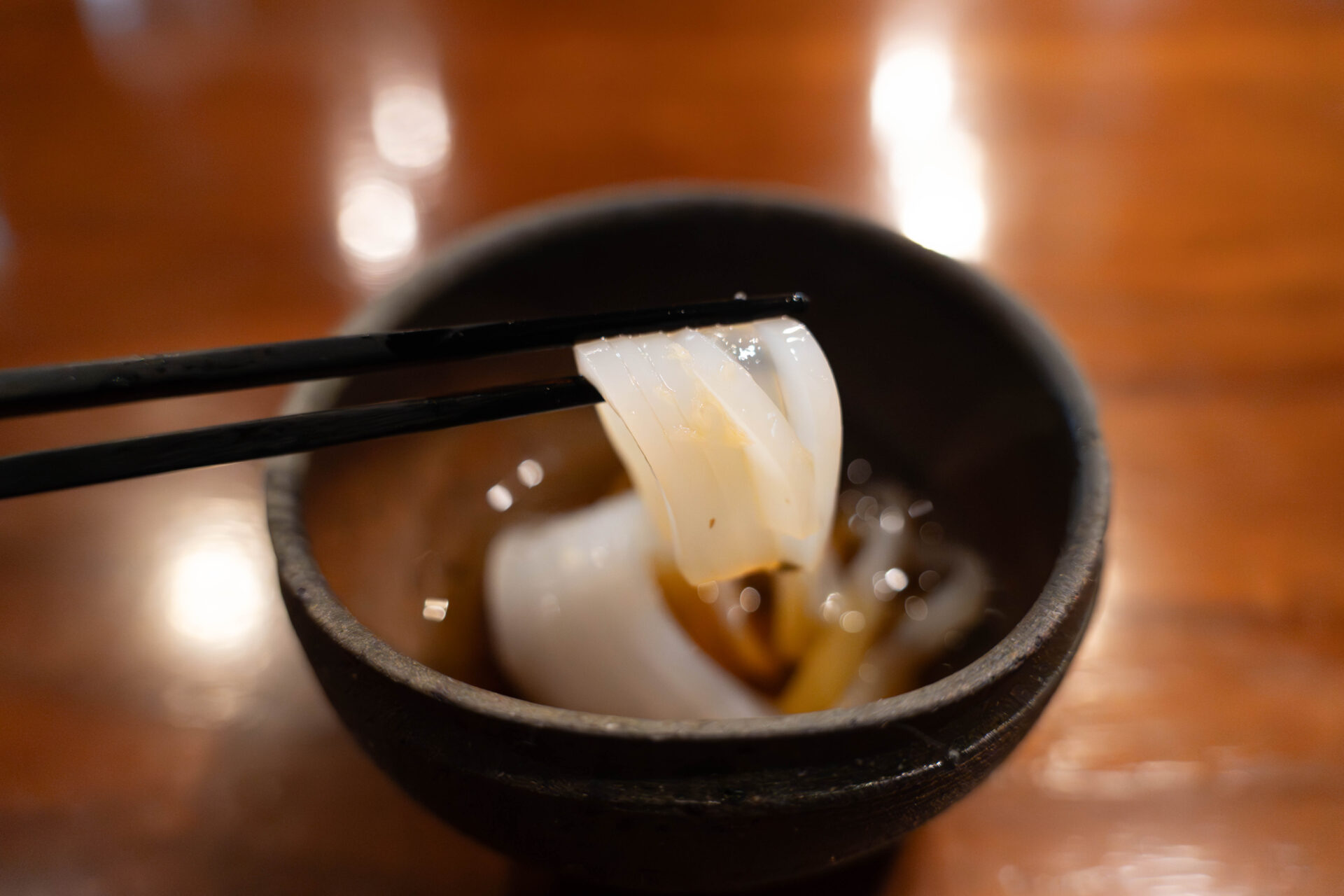
Sea Bream Sashimi (Tai no Otsukuri)
Next was sashimi of sea bream from Karatsu.
Each slice was lightly seasoned beforehand, meant to be enjoyed simply with a touch of wasabi if desired.
The flesh was tender and rich in umami, the pre-seasoning highlighting the fish’s natural sweetness.
Adding wasabi brought out the aroma and sharpened the flavors beautifully.
A seemingly simple dish, yet one that expressed balance and depth.
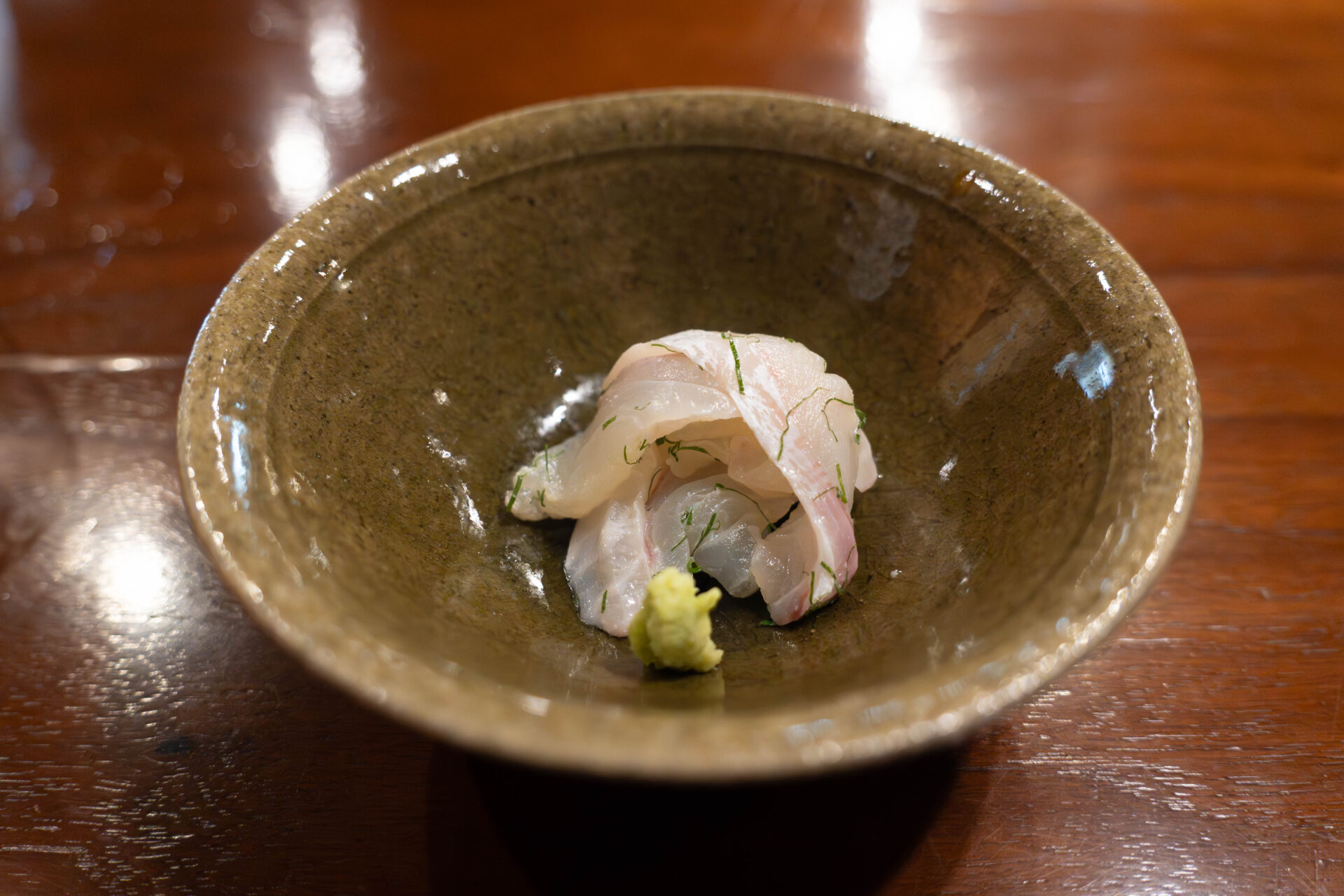
This course was paired with a natural Grüner Veltliner — crisp, aromatic, and well-suited to seafood.
Its clean acidity complemented the fish perfectly, extending the finish rather than competing with it.
Aru Tokoro offers not only sake but also a thoughtful list of natural wines, carefully chosen to harmonize with the food.
Like the dishes themselves, the wines blend seamlessly into the experience, unforced and genuine.
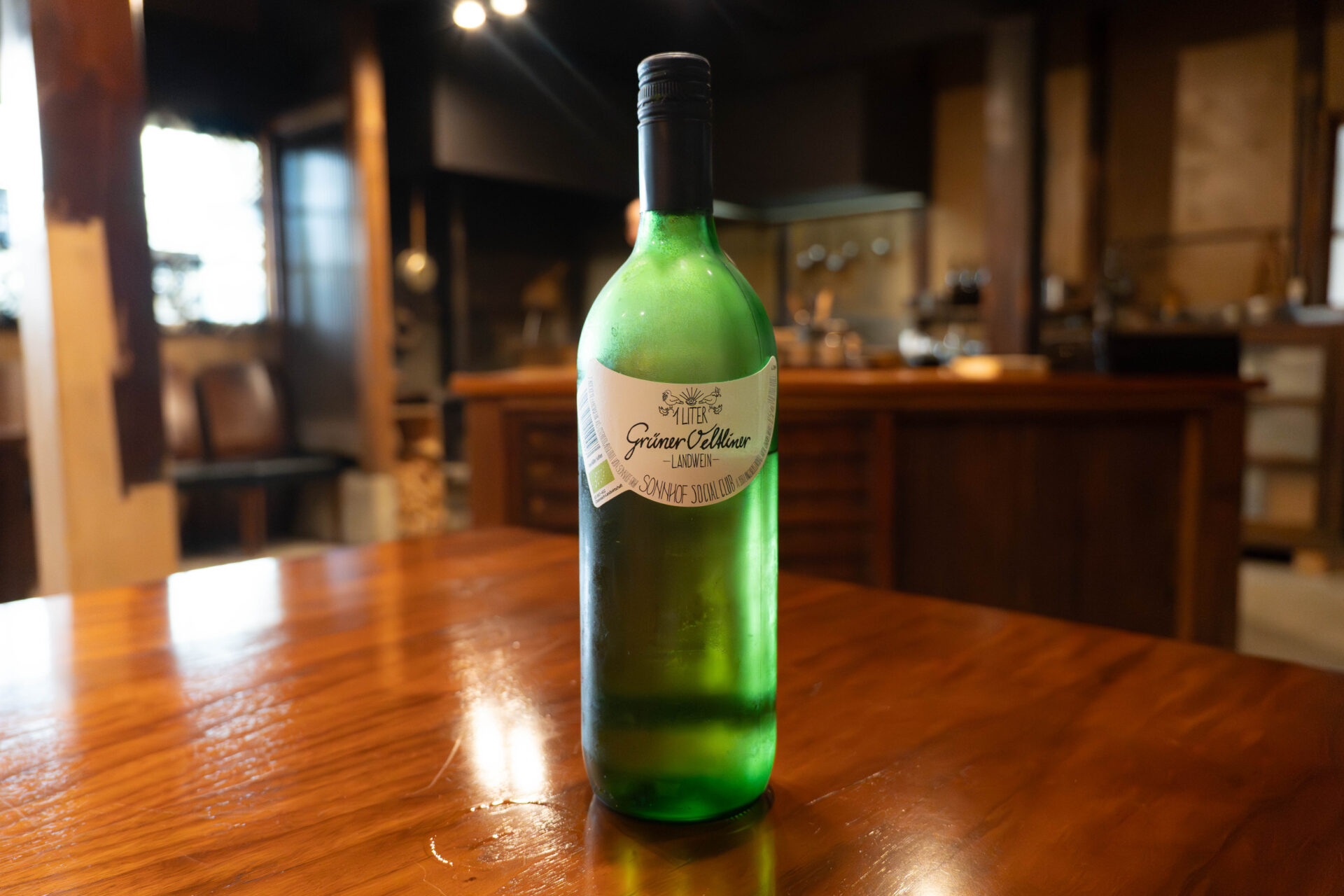
Eggplant Thickened with Kudzu (Nasu no Kuzu-jitate)
Served warm, this clear soup featured deep-fried eggplant enveloped in a kudzu-thickened dashi broth.
The broth, made carefully from bonito flakes, was crystal clear and aromatic, gently coating the tender eggplant.
Each bite released the fragrant essence of the dashi, while the eggplant itself was deeply seasoned and meltingly soft.
The smooth texture of the kudzu lent a comforting warmth — a dish that quietly nourished the soul.
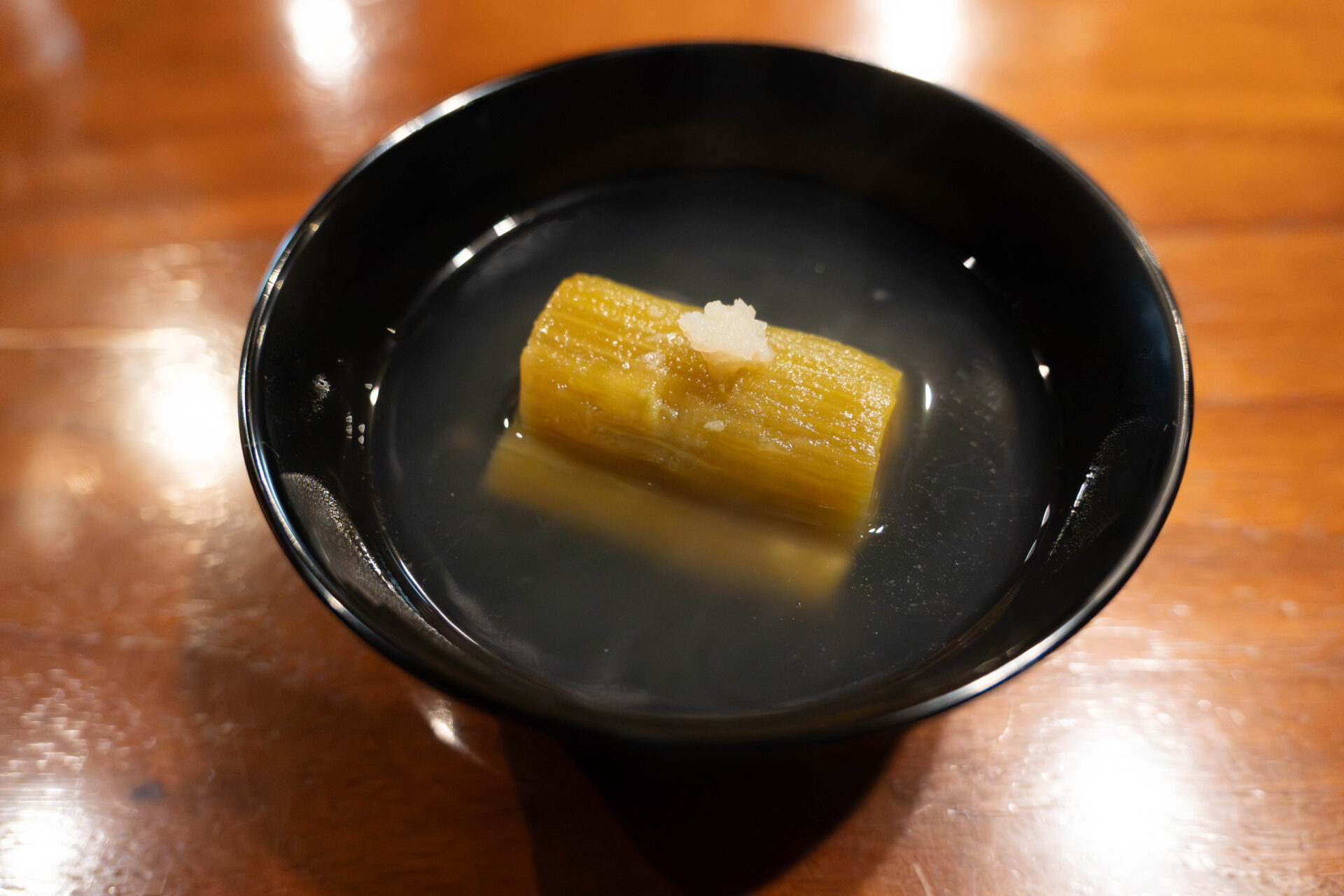
Summer Vegetable Tempura
A trio of summer vegetables — island okra, bitter melon, and sasage beans — were lightly fried into crisp tempura.
Served simply with seaweed salt.
Each vegetable’s distinct character came through beautifully: the okra’s pleasant stickiness, the bitterness of the goya, and the green aroma of the sasage.
The subtle salt drew out their sweetness, capturing the clear vitality of summer.
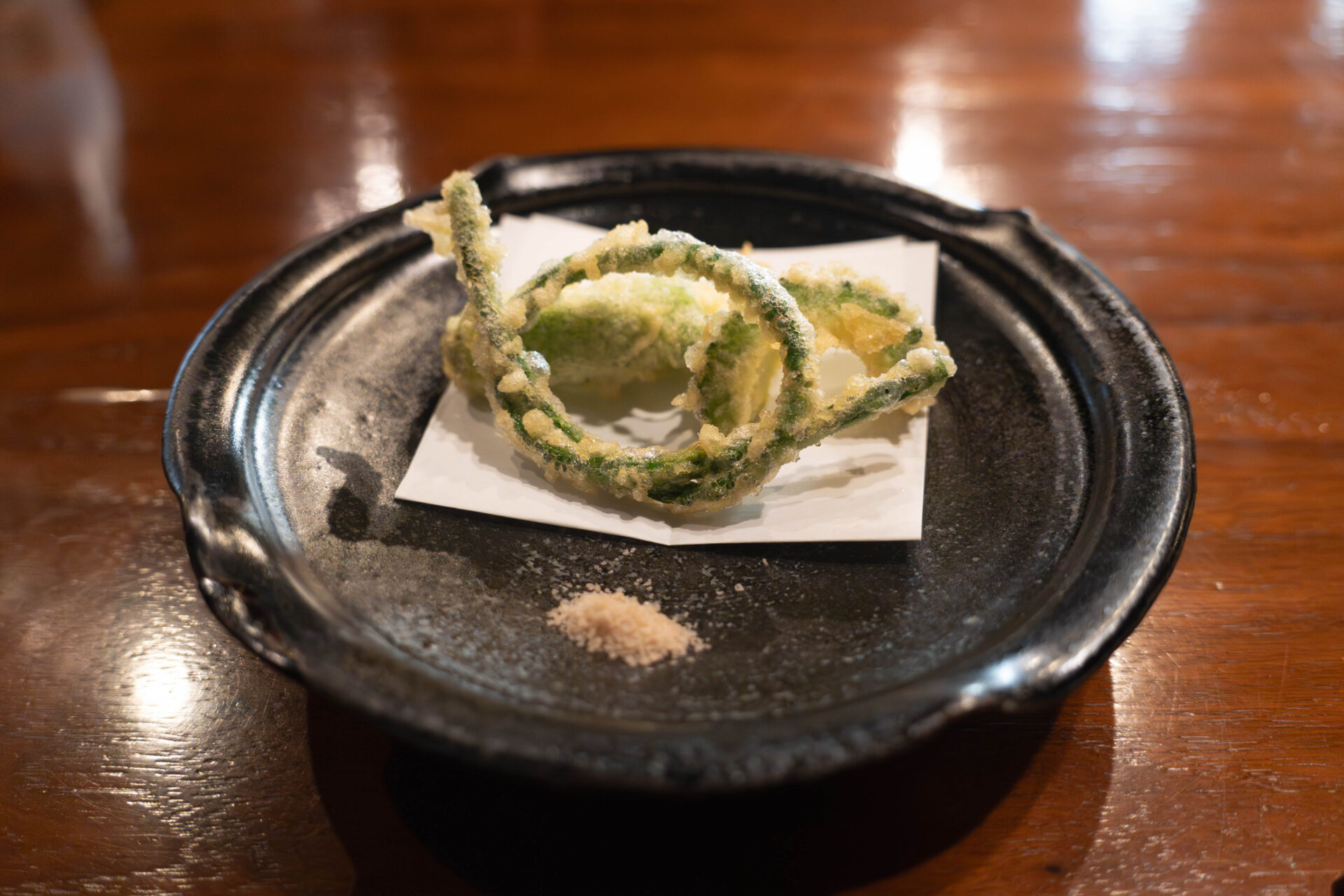
Kinzakura Pork Shoulder Loin Charcoal-Grilled (from Karatsu)
The main dish featured locally raised Kinzakura pork shoulder loin, grilled slowly over charcoal.
Cooked patiently and rested carefully, the meat’s natural flavor was drawn out to its fullest.
The meat was fine-grained with a refined sweetness in its fat, releasing rich umami with every bite.
It was not just tender, but satisfyingly firm — a texture that deepened the pleasure of eating.
The slight bitterness of the shishito pepper garnish balanced the pork’s sweetness perfectly.
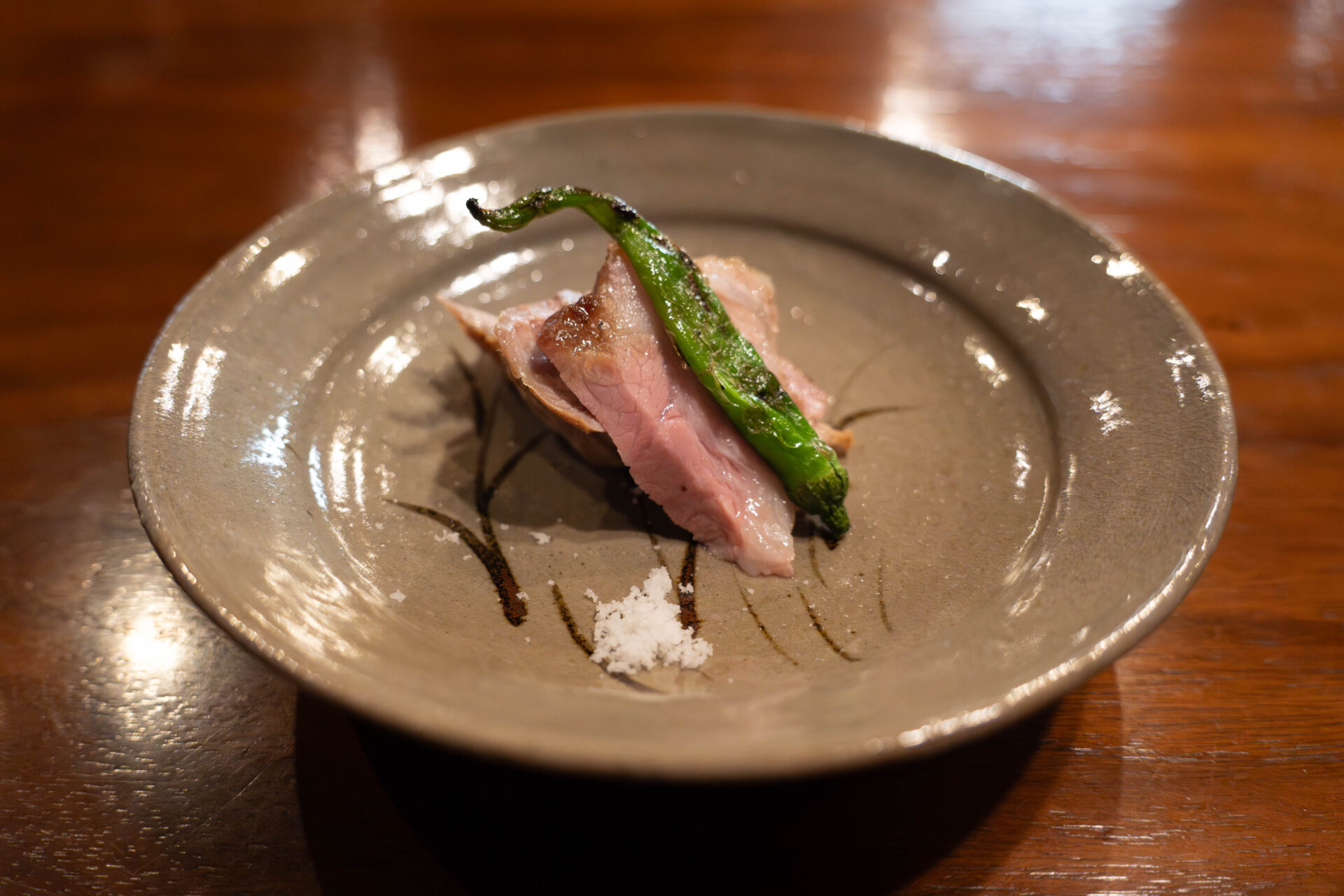
Hamo (Pike Conger) Shabu-shabu from Karatsu
Next came a hot pot of pike conger from Karatsu.
The broth, made from the fish’s bones and head, was clear yet deeply flavorful, carrying the fragrance of the sea.
The hamo was so fresh it could be eaten raw, though Chef recommended dipping it for just 10–20 seconds for the ideal texture.
Lightly cooked, the fish turned fluffy yet resilient, releasing elegant sweetness as it melted in the mouth.
Seasonal vegetables such as mizuna added natural sweetness to the broth, which grew richer with every bite.
By the end, the dashi itself became a complete dish — a beautiful harmony of land and sea from Karatsu.
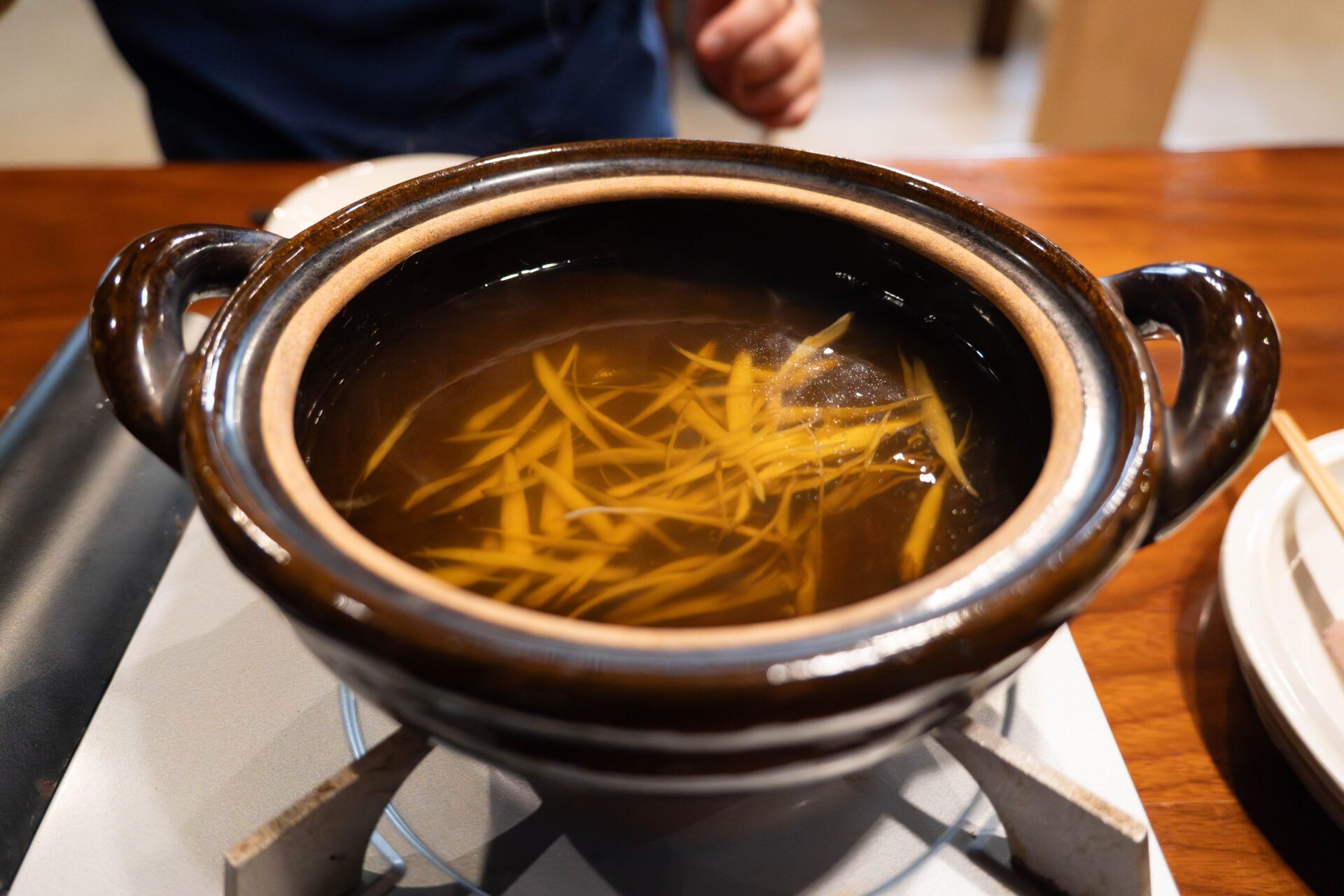
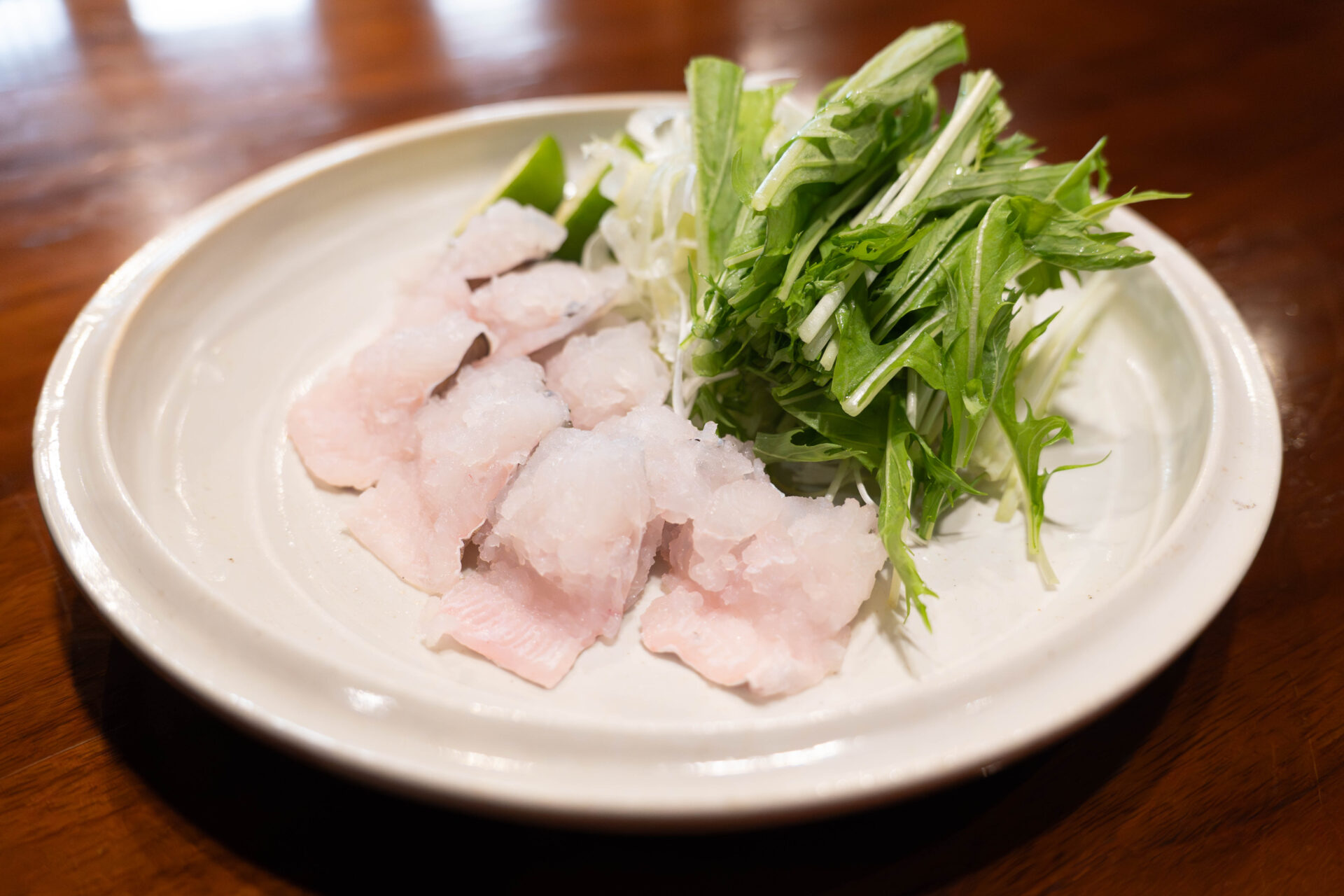
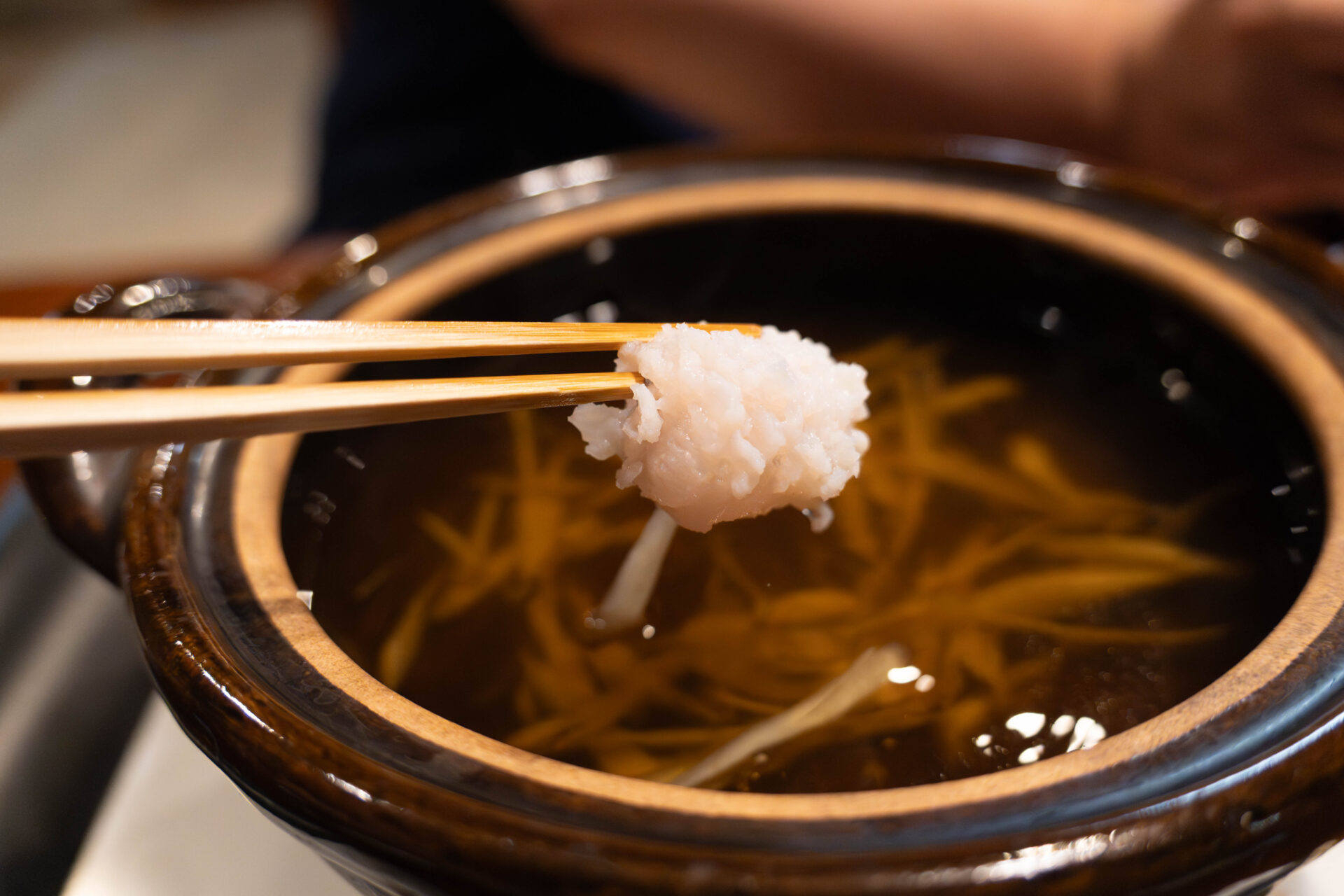
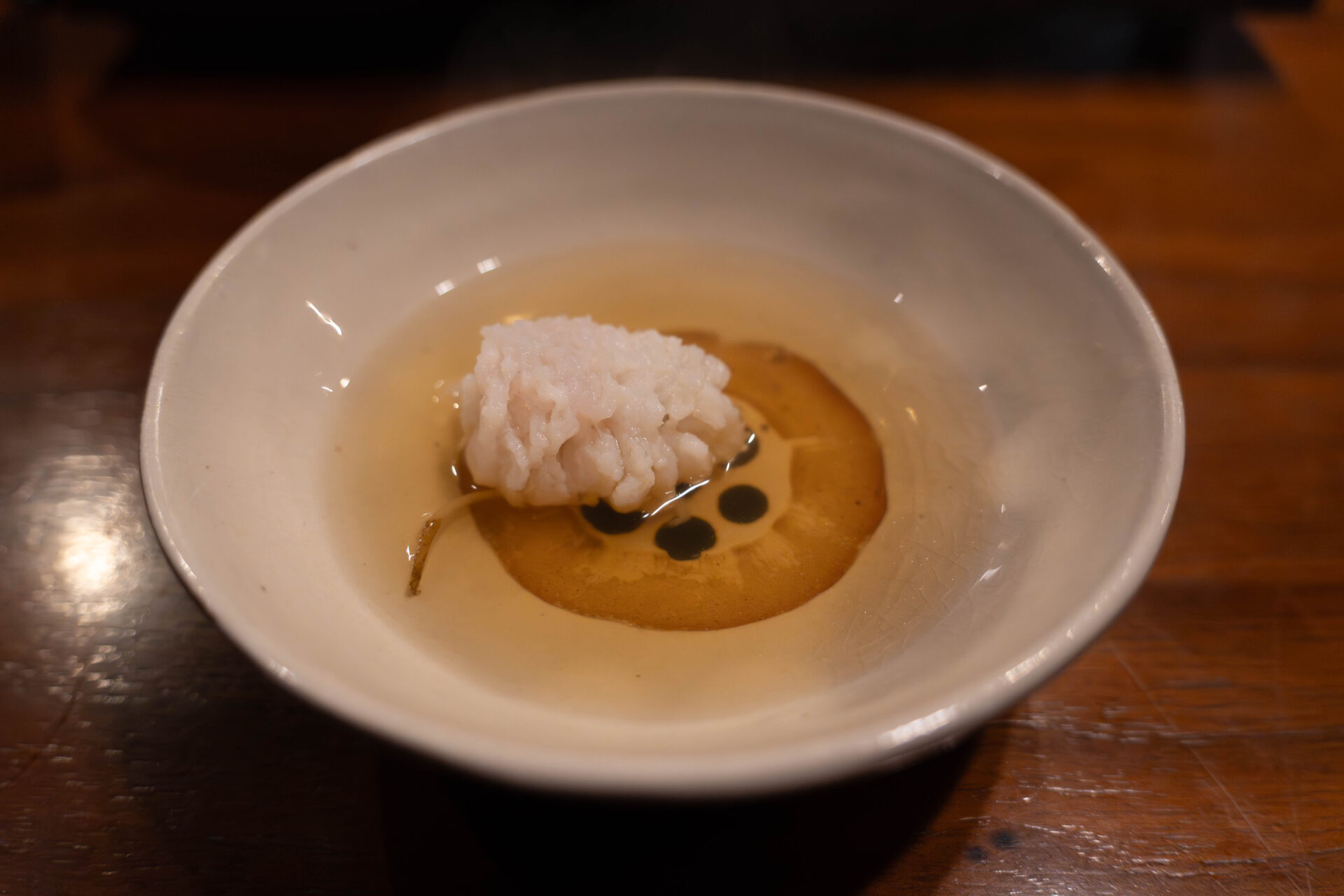
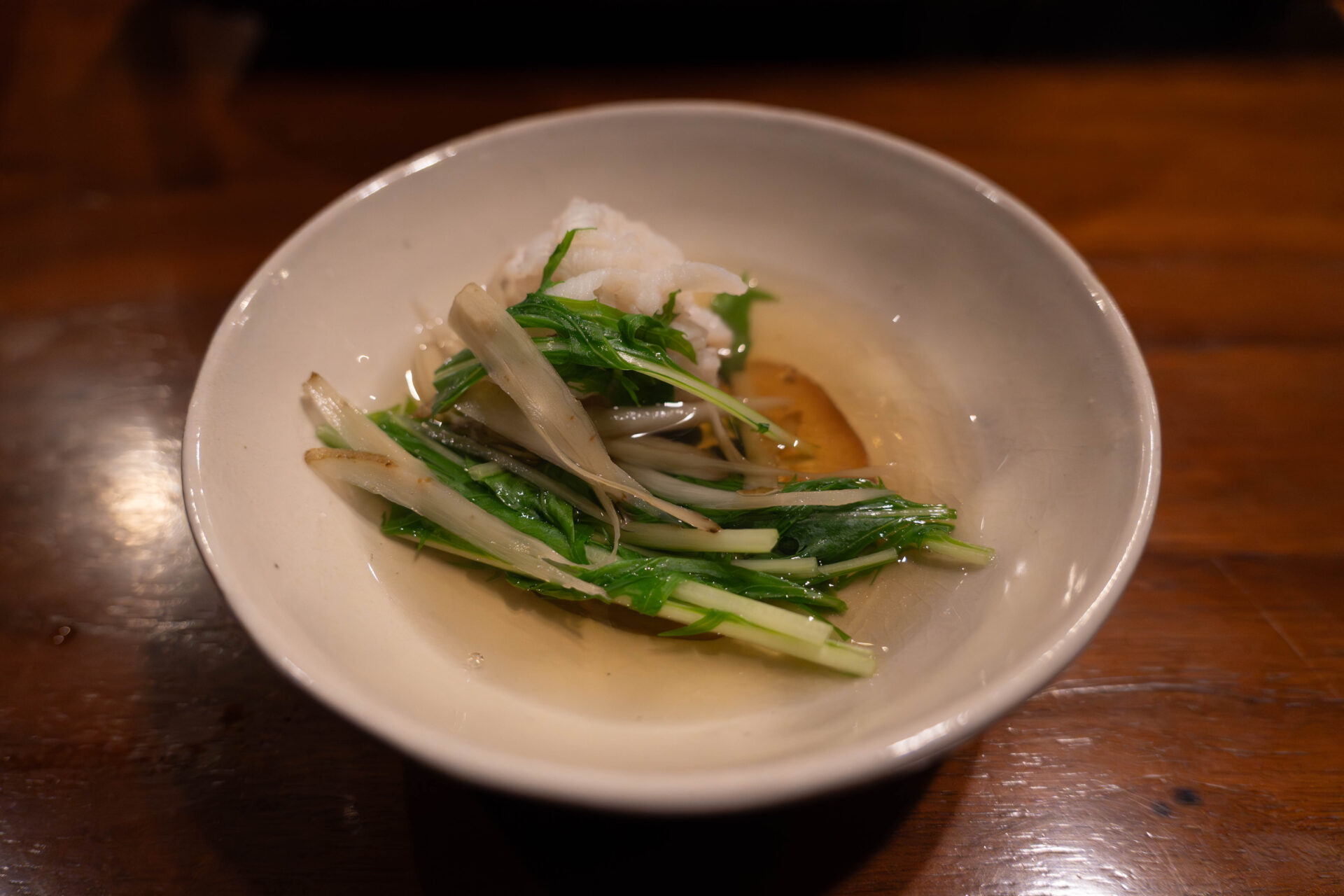
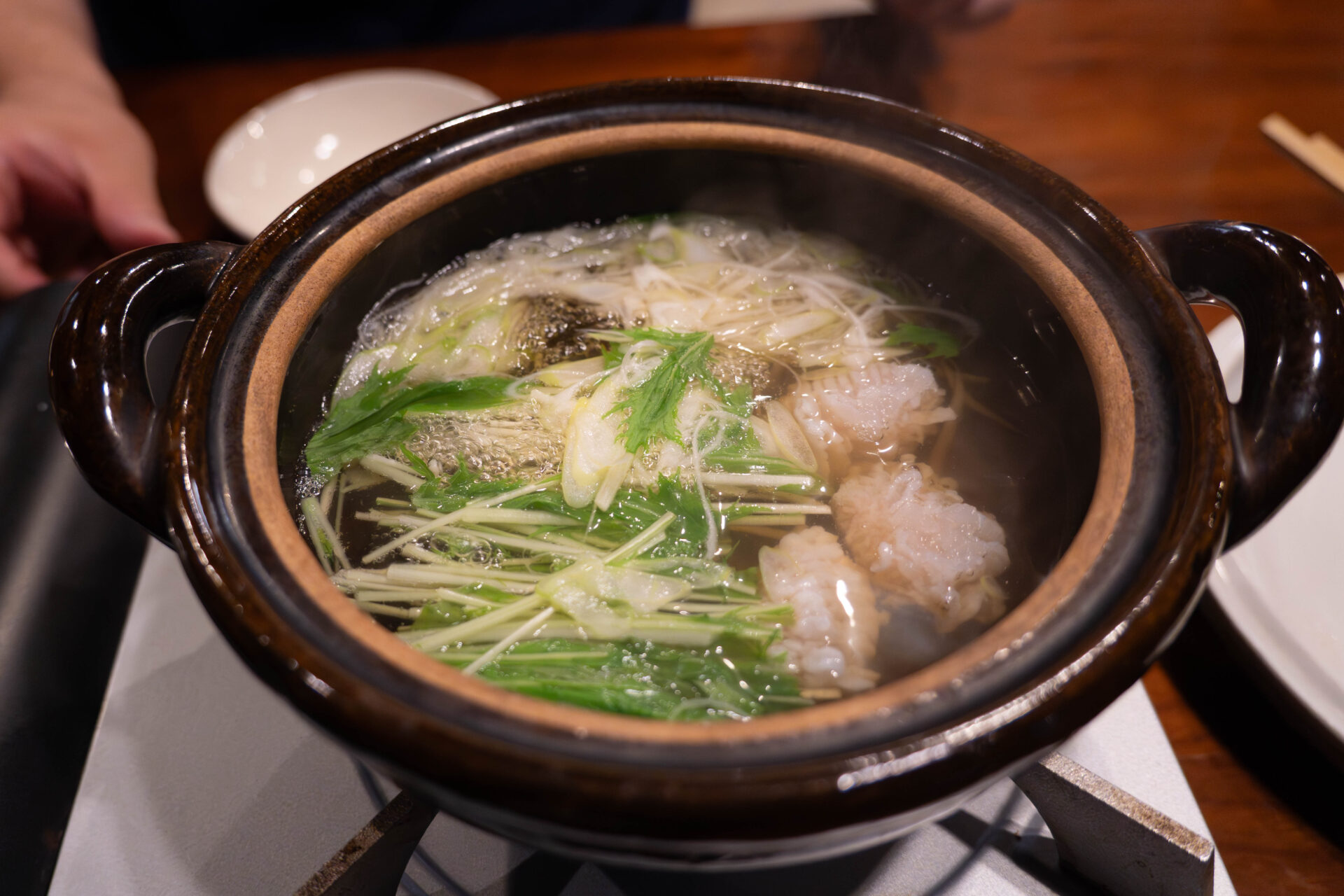
Onigiri and Natto Soup
For the finale came the long-awaited onigiri — rice balls shaped by the chef’s hands from freshly cooked, steaming rice straight from the kamado stove.
Served with simple pickles, the rice’s sweetness and aroma stood out vividly, each bite firm and full of life.
Paired with natto miso soup, made with zaru-dofu (fresh tofu) from the long-established Kawashima Tofu Shop in Karatsu.
Inherited from his training at “Tarafuku Manma,” this onigiri truly represents the essence of Aru Tokoro — simple, soulful, and deeply satisfying.
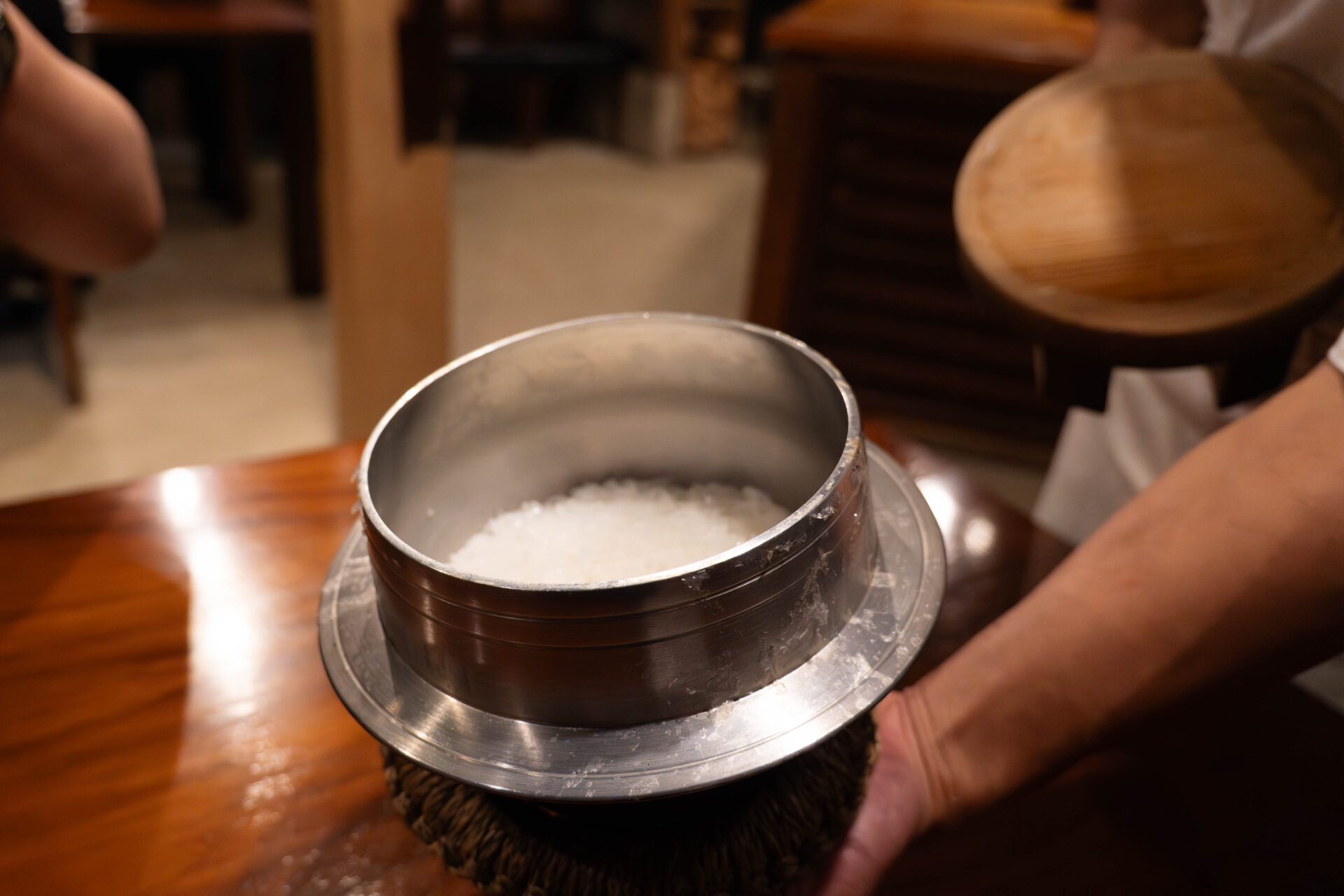
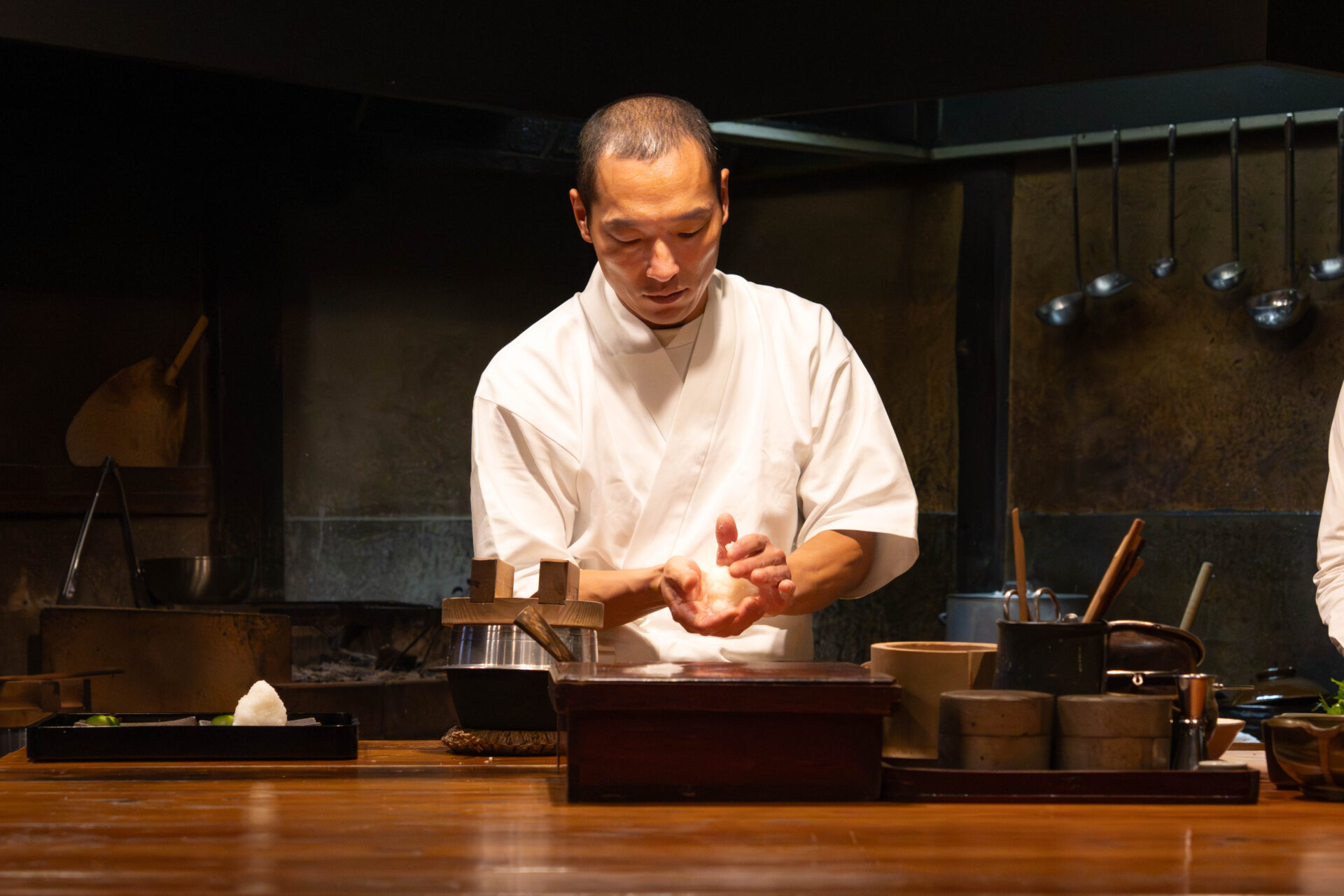
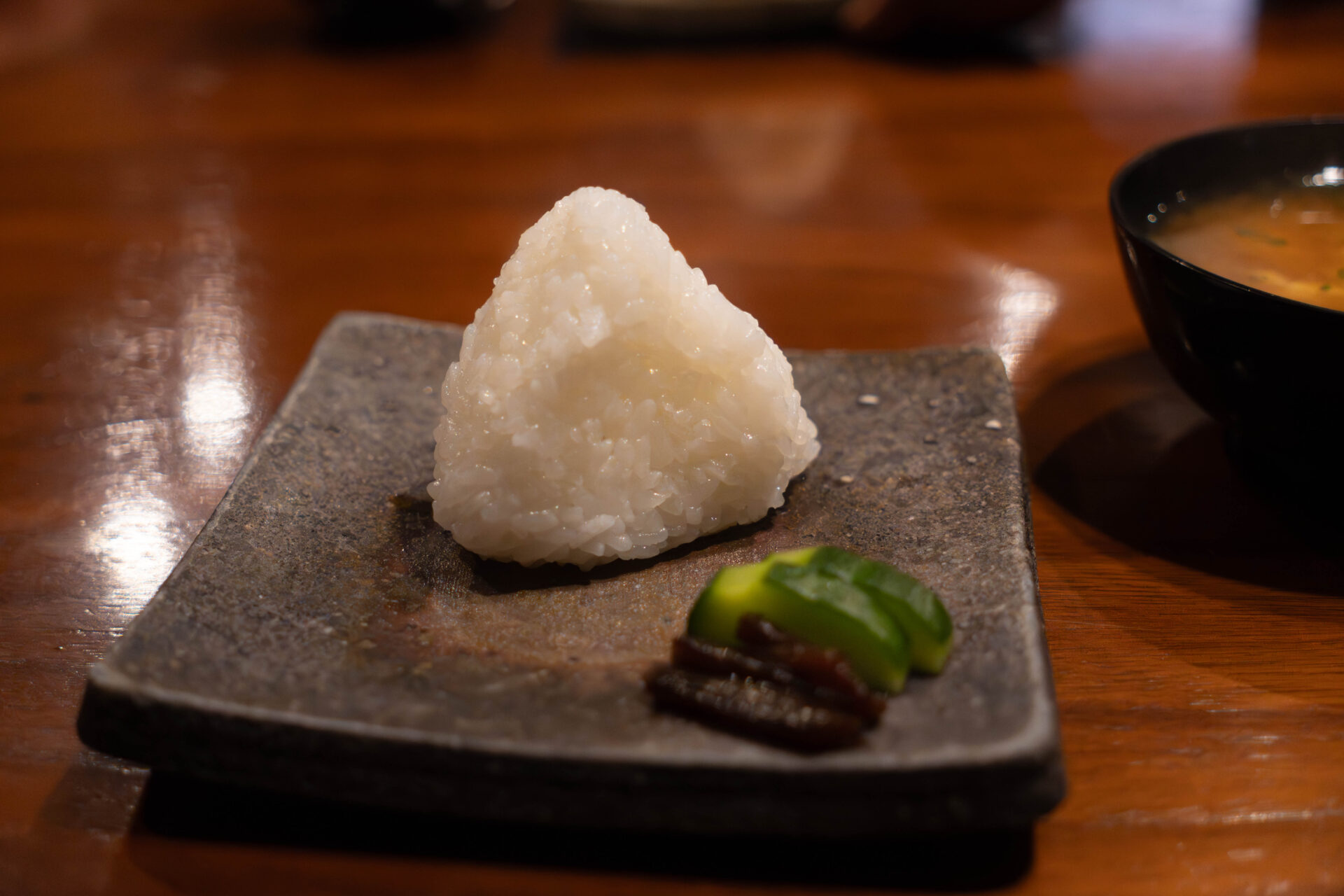
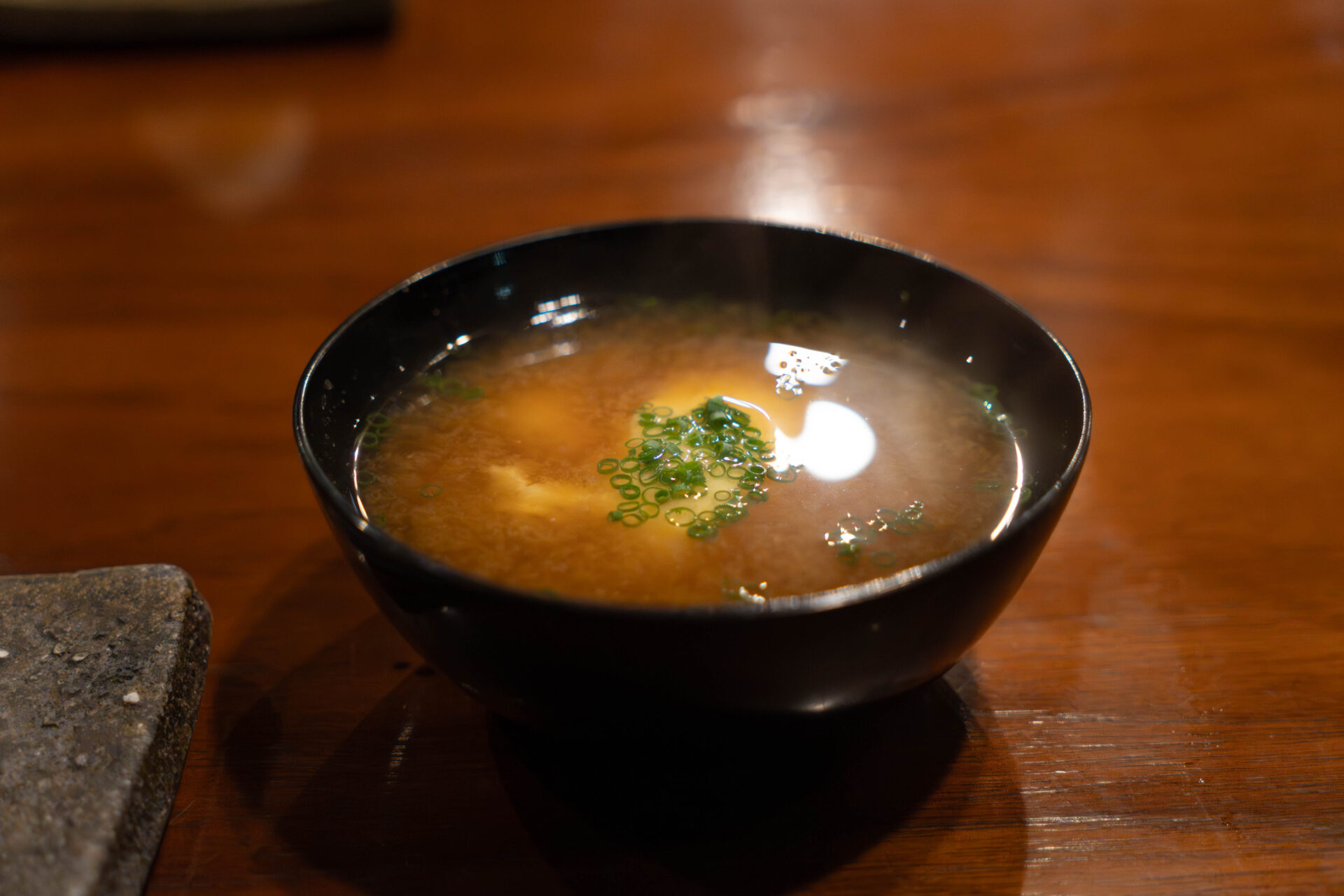
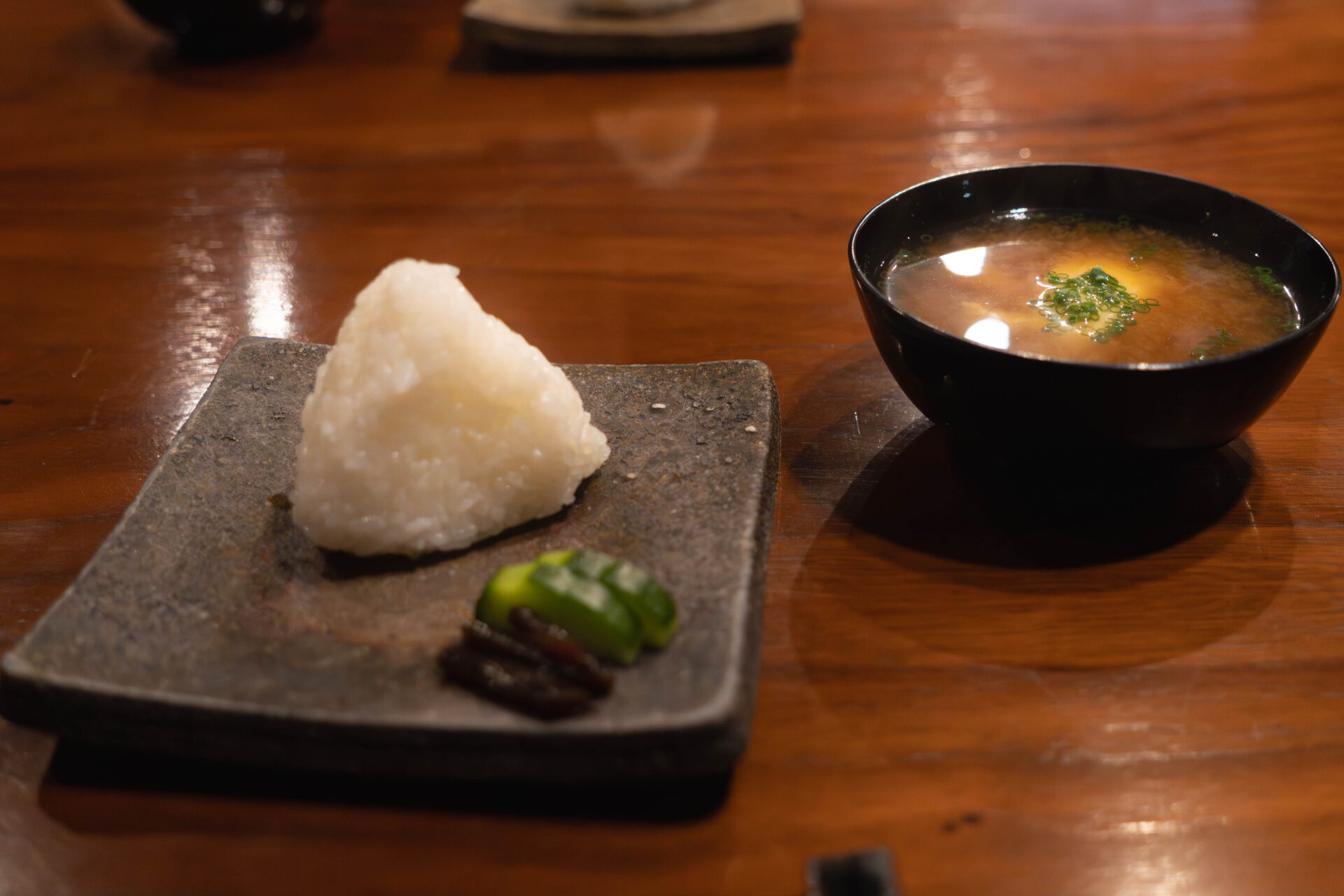
Onigiri (Second Serving) with Homemade Chirimen Sansho
Guests are welcome to ask for another onigiri.
This time, it was mixed with the restaurant’s own chirimen sansho (baby sardines simmered with Japanese pepper) and wrapped in fragrant nori.
The subtle heat of the sansho and the umami of the chirimen highlighted the sweetness of the rice, making for a deeply aromatic second serving — a fitting reflection of the chef’s meticulous spirit.
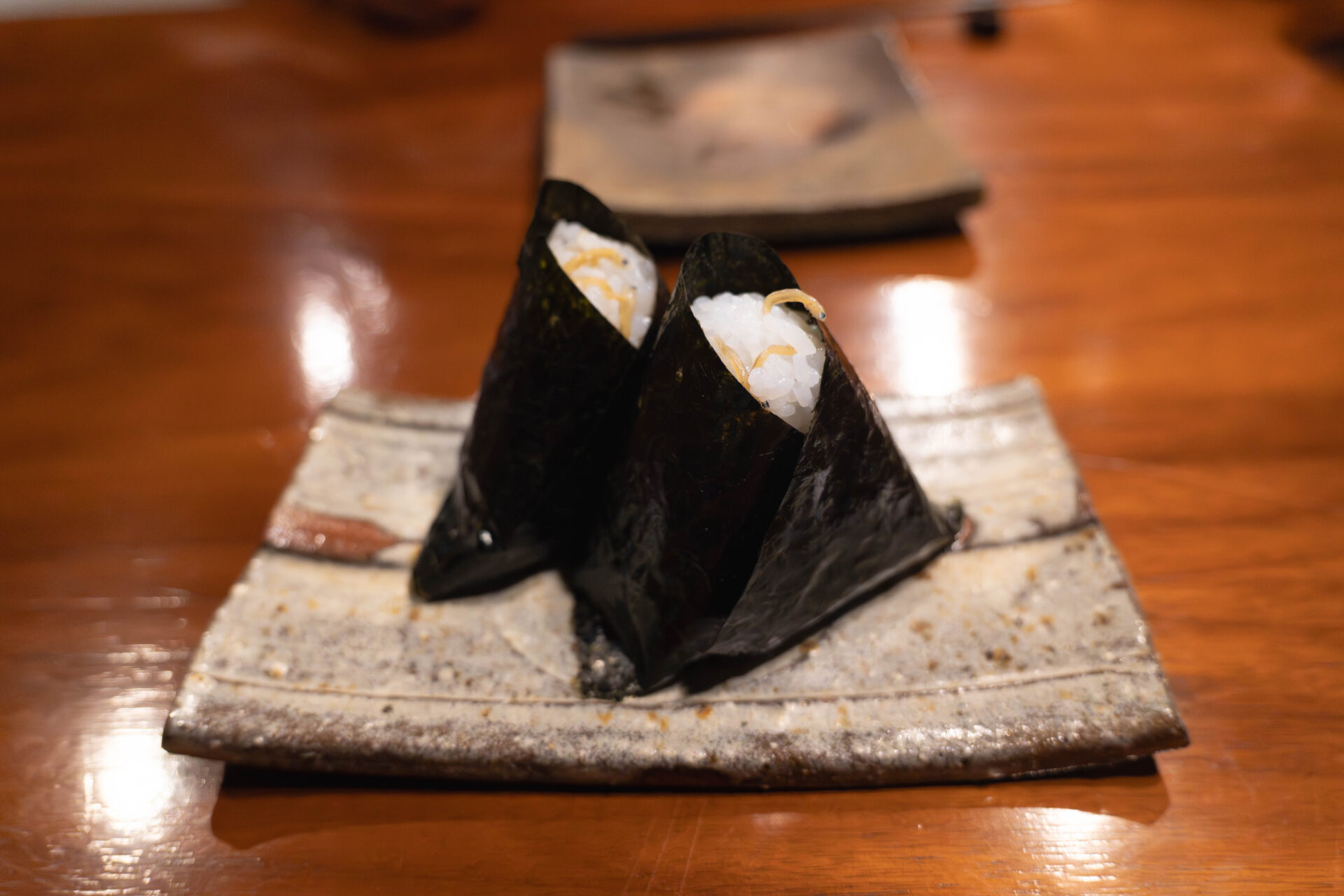
Onigiri (Second Serving) with Homemade Pickled Plum
Another version featured homemade umeboshi (pickled plum) inside.
The sweet, steamy rice contrasted with the plum’s sharp acidity and saltiness, rounded by the roasted scent of nori.
Simple yet profound — a closing dish that lingered in both flavor and feeling.
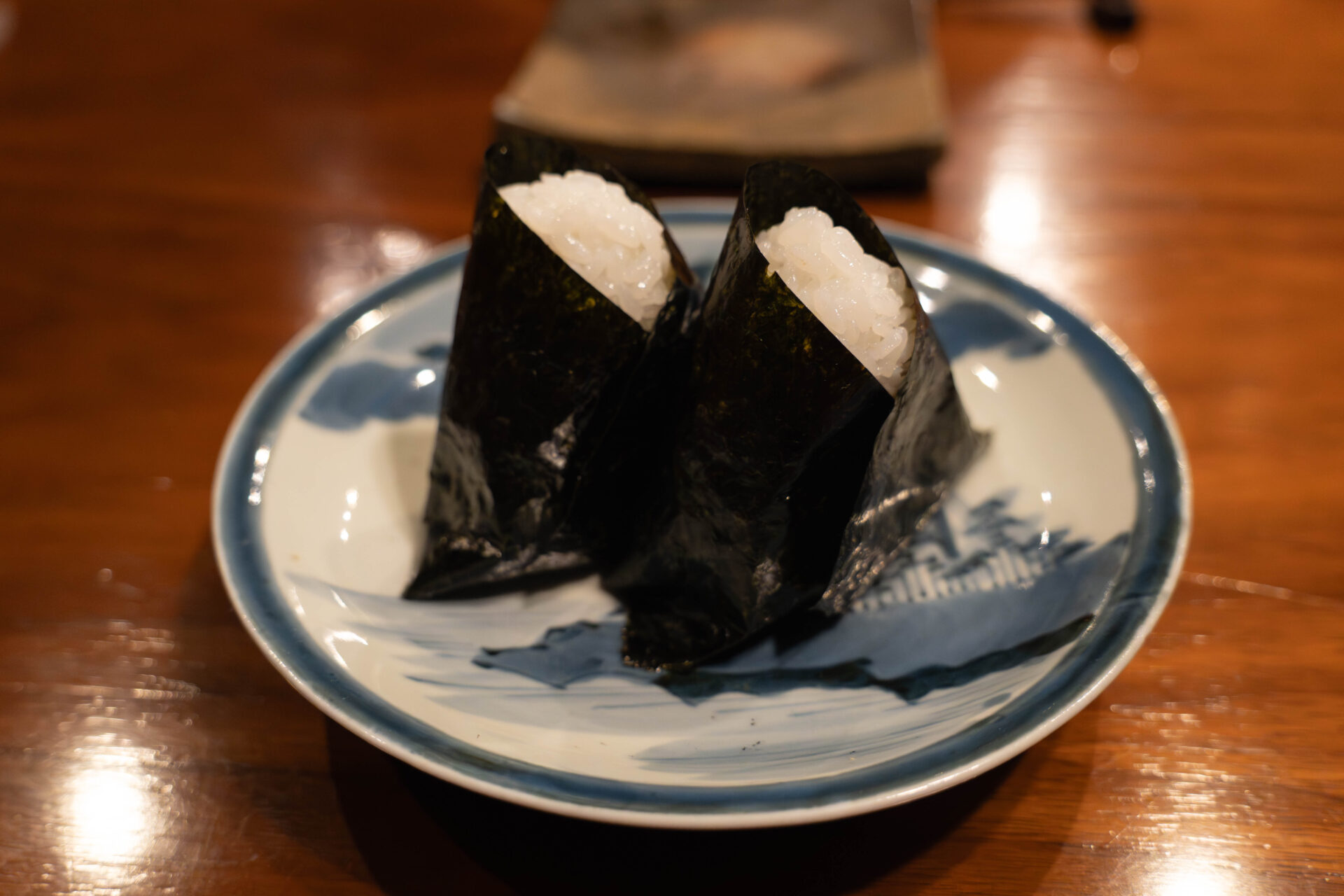
Dessert & Finale
Homemade Zunda Mochi
For dessert, homemade zunda mochi — soft rice cakes coated in a paste of fresh edamame.
Smooth and rich, the bean paste exuded freshness and depth of flavor.
Each bite carried the presence of the edamame itself, mildly sweet and earthy.
A dessert so memorable and honest in taste, one could only wish it were available to take home.
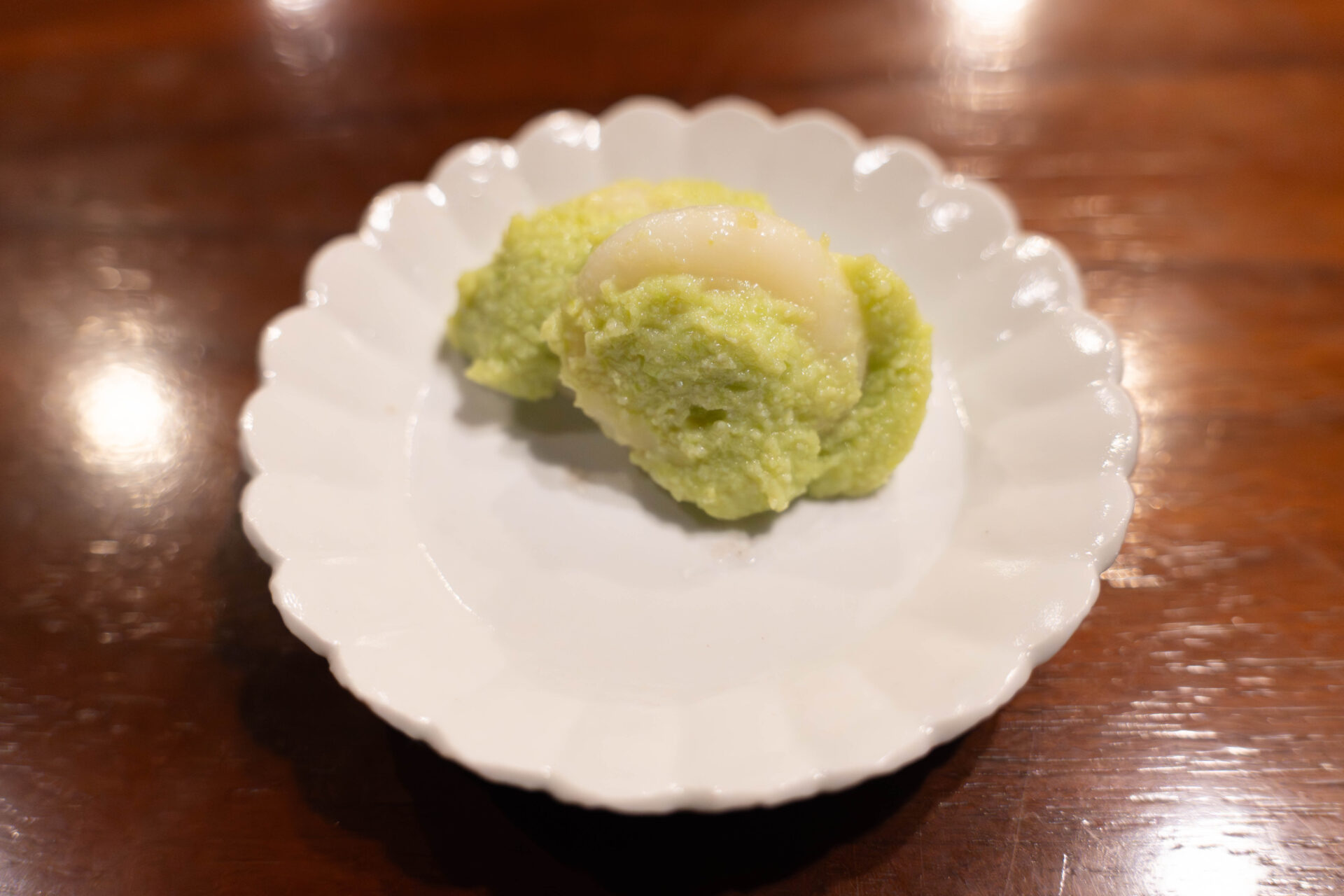
Impressions
Dining at “Aru Tokoro,” nestled at the foot of Mt. Kagamiyama in Karatsu, felt like journeying through the pages of an old tale — each dish capturing the air and spirit of the season and land.
Though modest in appearance, every plate — from the fresh vegetables and seafood to the kamado-cooked rice — conveyed the ingredients’ true essence, elevated by Chef Hirakawa’s mastery of restraint.
The space, self-designed and transformed from tatami to doma, resonated with the food itself.
The displayed Ebisu roof tile and soft clarinet duets deepened the sense of story, enveloping diners as if they had stepped into a folktale scene.
A simplicity reminiscent of ichiju-sansai, a purity that celebrates the gifts of the land —
and, at the heart of it all, the kamado-cooked onigiri from his days at “Tarafuku Manma” — the soul of this restaurant.
True to its name, “Aru Tokoro” offers each guest the chance to find their own “certain place.”
Through its food and space, one leaves carrying the quiet continuation of a story within.
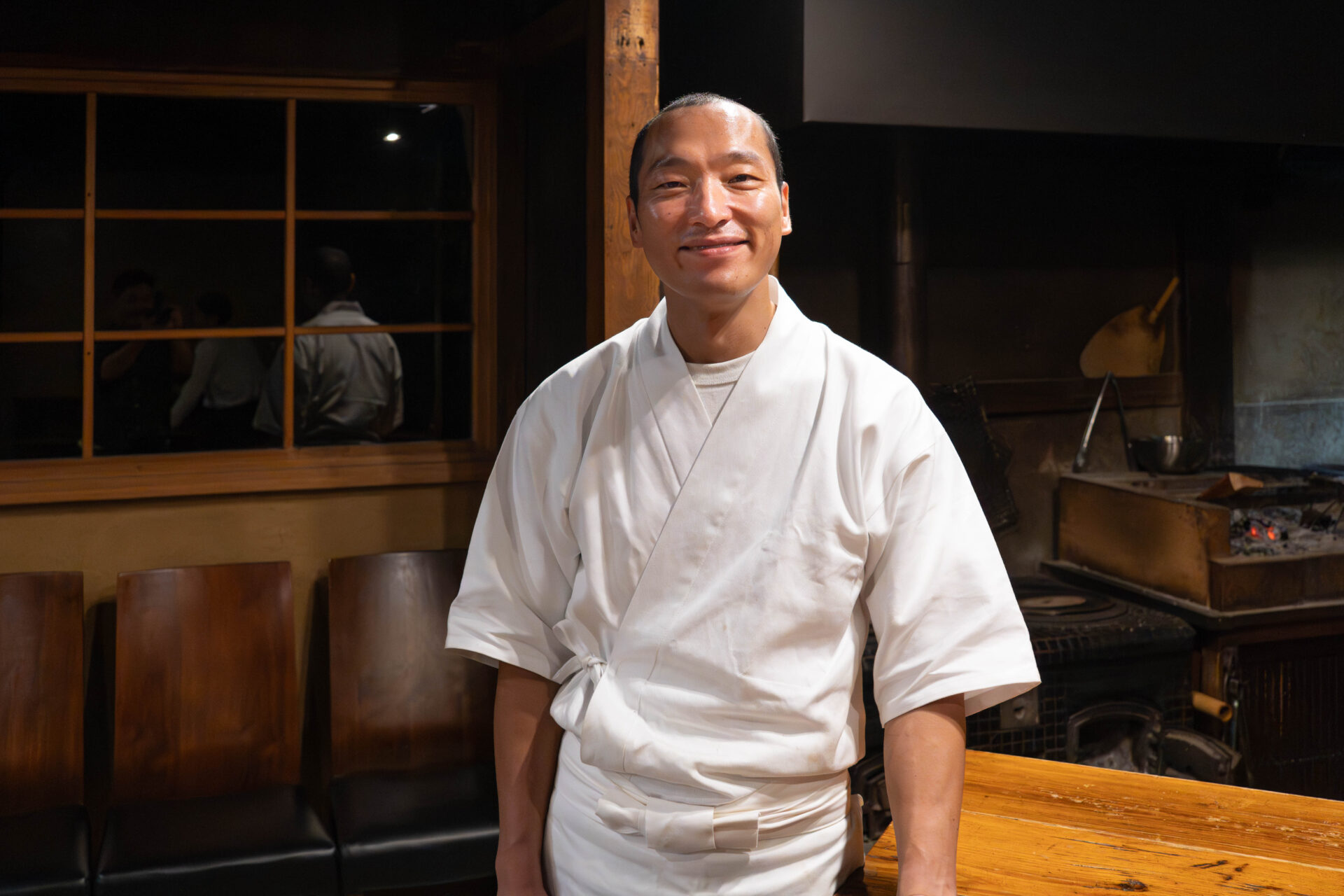
Reservations & Access
Reservations
-
By phone: 0955-58-8898
-
Reservations required: course meals only.
-
Available for parties of two or more, reservation at least one day in advance.
Access
-
Address: 732 Kagami, Karatsu City, Saga Prefecture
-
Nearest Station: Approximately 2 km from Nijinomatsubara Station (not within walking distance)
-
By Car: About 10 minutes from Higashi-Karatsu Station.
-
By Bus: About a 2-minute walk from “Kajiwara Iriguchi” bus stop.
-
Parking: Available on-site.
Hours & Closed Days
-
Lunch: 11:00 AM – 3:00 PM
-
Dinner: 5:00 PM – 10:00 PM
-
Closed: Irregular holidays
- TAGS

